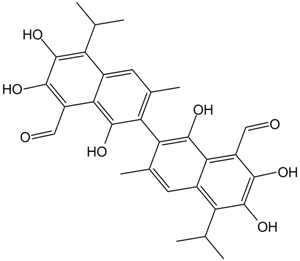Apoptosis
As one of the cellular death mechanisms, apoptosis, also known as programmed cell death, can be defined as the process of a proper death of any cell under certain or necessary conditions. Apoptosis is controlled by the interactions between several molecules and responsible for the elimination of unwanted cells from the body.
Many biochemical events and a series of morphological changes occur at the early stage and increasingly continue till the end of apoptosis process. Morphological event cascade including cytoplasmic filament aggregation, nuclear condensation, cellular fragmentation, and plasma membrane blebbing finally results in the formation of apoptotic bodies. Several biochemical changes such as protein modifications/degradations, DNA and chromatin deteriorations, and synthesis of cell surface markers form morphological process during apoptosis.
Apoptosis can be stimulated by two different pathways: (1) intrinsic pathway (or mitochondria pathway) that mainly occurs via release of cytochrome c from the mitochondria and (2) extrinsic pathway when Fas death receptor is activated by a signal coming from the outside of the cell.
Different gene families such as caspases, inhibitor of apoptosis proteins, B cell lymphoma (Bcl)-2 family, tumor necrosis factor (TNF) receptor gene superfamily, or p53 gene are involved and/or collaborate in the process of apoptosis.
Caspase family comprises conserved cysteine aspartic-specific proteases, and members of caspase family are considerably crucial in the regulation of apoptosis. There are 14 different caspases in mammals, and they are basically classified as the initiators including caspase-2, -8, -9, and -10; and the effectors including caspase-3, -6, -7, and -14; and also the cytokine activators including caspase-1, -4, -5, -11, -12, and -13. In vertebrates, caspase-dependent apoptosis occurs through two main interconnected pathways which are intrinsic and extrinsic pathways. The intrinsic or mitochondrial apoptosis pathway can be activated through various cellular stresses that lead to cytochrome c release from the mitochondria and the formation of the apoptosome, comprised of APAF1, cytochrome c, ATP, and caspase-9, resulting in the activation of caspase-9. Active caspase-9 then initiates apoptosis by cleaving and thereby activating executioner caspases. The extrinsic apoptosis pathway is activated through the binding of a ligand to a death receptor, which in turn leads, with the help of the adapter proteins (FADD/TRADD), to recruitment, dimerization, and activation of caspase-8 (or 10). Active caspase-8 (or 10) then either initiates apoptosis directly by cleaving and thereby activating executioner caspase (-3, -6, -7), or activates the intrinsic apoptotic pathway through cleavage of BID to induce efficient cell death. In a heat shock-induced death, caspase-2 induces apoptosis via cleavage of Bid.
Bcl-2 family members are divided into three subfamilies including (i) pro-survival subfamily members (Bcl-2, Bcl-xl, Bcl-W, MCL1, and BFL1/A1), (ii) BH3-only subfamily members (Bad, Bim, Noxa, and Puma9), and (iii) pro-apoptotic mediator subfamily members (Bax and Bak). Following activation of the intrinsic pathway by cellular stress, pro‑apoptotic BCL‑2 homology 3 (BH3)‑only proteins inhibit the anti‑apoptotic proteins Bcl‑2, Bcl-xl, Bcl‑W and MCL1. The subsequent activation and oligomerization of the Bak and Bax result in mitochondrial outer membrane permeabilization (MOMP). This results in the release of cytochrome c and SMAC from the mitochondria. Cytochrome c forms a complex with caspase-9 and APAF1, which leads to the activation of caspase-9. Caspase-9 then activates caspase-3 and caspase-7, resulting in cell death. Inhibition of this process by anti‑apoptotic Bcl‑2 proteins occurs via sequestration of pro‑apoptotic proteins through binding to their BH3 motifs.
One of the most important ways of triggering apoptosis is mediated through death receptors (DRs), which are classified in TNF superfamily. There exist six DRs: DR1 (also called TNFR1); DR2 (also called Fas); DR3, to which VEGI binds; DR4 and DR5, to which TRAIL binds; and DR6, no ligand has yet been identified that binds to DR6. The induction of apoptosis by TNF ligands is initiated by binding to their specific DRs, such as TNFα/TNFR1, FasL /Fas (CD95, DR2), TRAIL (Apo2L)/DR4 (TRAIL-R1) or DR5 (TRAIL-R2). When TNF-α binds to TNFR1, it recruits a protein called TNFR-associated death domain (TRADD) through its death domain (DD). TRADD then recruits a protein called Fas-associated protein with death domain (FADD), which then sequentially activates caspase-8 and caspase-3, and thus apoptosis. Alternatively, TNF-α can activate mitochondria to sequentially release ROS, cytochrome c, and Bax, leading to activation of caspase-9 and caspase-3 and thus apoptosis. Some of the miRNAs can inhibit apoptosis by targeting the death-receptor pathway including miR-21, miR-24, and miR-200c.
p53 has the ability to activate intrinsic and extrinsic pathways of apoptosis by inducing transcription of several proteins like Puma, Bid, Bax, TRAIL-R2, and CD95.
Some inhibitors of apoptosis proteins (IAPs) can inhibit apoptosis indirectly (such as cIAP1/BIRC2, cIAP2/BIRC3) or inhibit caspase directly, such as XIAP/BIRC4 (inhibits caspase-3, -7, -9), and Bruce/BIRC6 (inhibits caspase-3, -6, -7, -8, -9).
Any alterations or abnormalities occurring in apoptotic processes contribute to development of human diseases and malignancies especially cancer.
References:
1.Yağmur Kiraz, Aysun Adan, Melis Kartal Yandim, et al. Major apoptotic mechanisms and genes involved in apoptosis[J]. Tumor Biology, 2016, 37(7):8471.
2.Aggarwal B B, Gupta S C, Kim J H. Historical perspectives on tumor necrosis factor and its superfamily: 25 years later, a golden journey.[J]. Blood, 2012, 119(3):651.
3.Ashkenazi A, Fairbrother W J, Leverson J D, et al. From basic apoptosis discoveries to advanced selective BCL-2 family inhibitors[J]. Nature Reviews Drug Discovery, 2017.
4.McIlwain D R, Berger T, Mak T W. Caspase functions in cell death and disease[J]. Cold Spring Harbor perspectives in biology, 2013, 5(4): a008656.
5.Ola M S, Nawaz M, Ahsan H. Role of Bcl-2 family proteins and caspases in the regulation of apoptosis[J]. Molecular and cellular biochemistry, 2011, 351(1-2): 41-58.
What is Apoptosis? The Apoptotic Pathways and the Caspase Cascade
Ziele für Apoptosis
- Pyroptosis(15)
- Caspase(77)
- 14.3.3 Proteins(3)
- Apoptosis Inducers(71)
- Bax(15)
- Bcl-2 Family(136)
- Bcl-xL(13)
- c-RET(15)
- IAP(32)
- KEAP1-Nrf2(73)
- MDM2(21)
- p53(137)
- PC-PLC(6)
- PKD(8)
- RasGAP (Ras- P21)(2)
- Survivin(8)
- Thymidylate Synthase(12)
- TNF-α(141)
- Other Apoptosis(1145)
- Apoptosis Detection(0)
- Caspase Substrate(0)
- APC(6)
- PD-1/PD-L1 interaction(60)
- ASK1(4)
- PAR4(2)
- RIP kinase(47)
- FKBP(22)
Produkte für Apoptosis
- Bestell-Nr. Artikelname Informationen
-
GC10610
Adapalene
Adapalen (CD271), ein synthetisches Retinoid der dritten Generation, wird hÄufig fÜr die Erforschung von Akne verwendet.
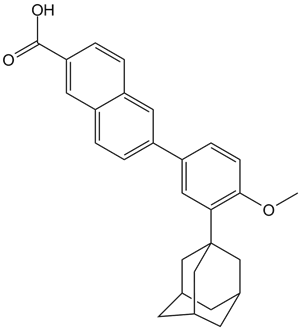
-
GC46798
Adapalene-d3
An internal standard for the quantification of adapalene

-
GC13959
Adarotene
An atypical retinoid
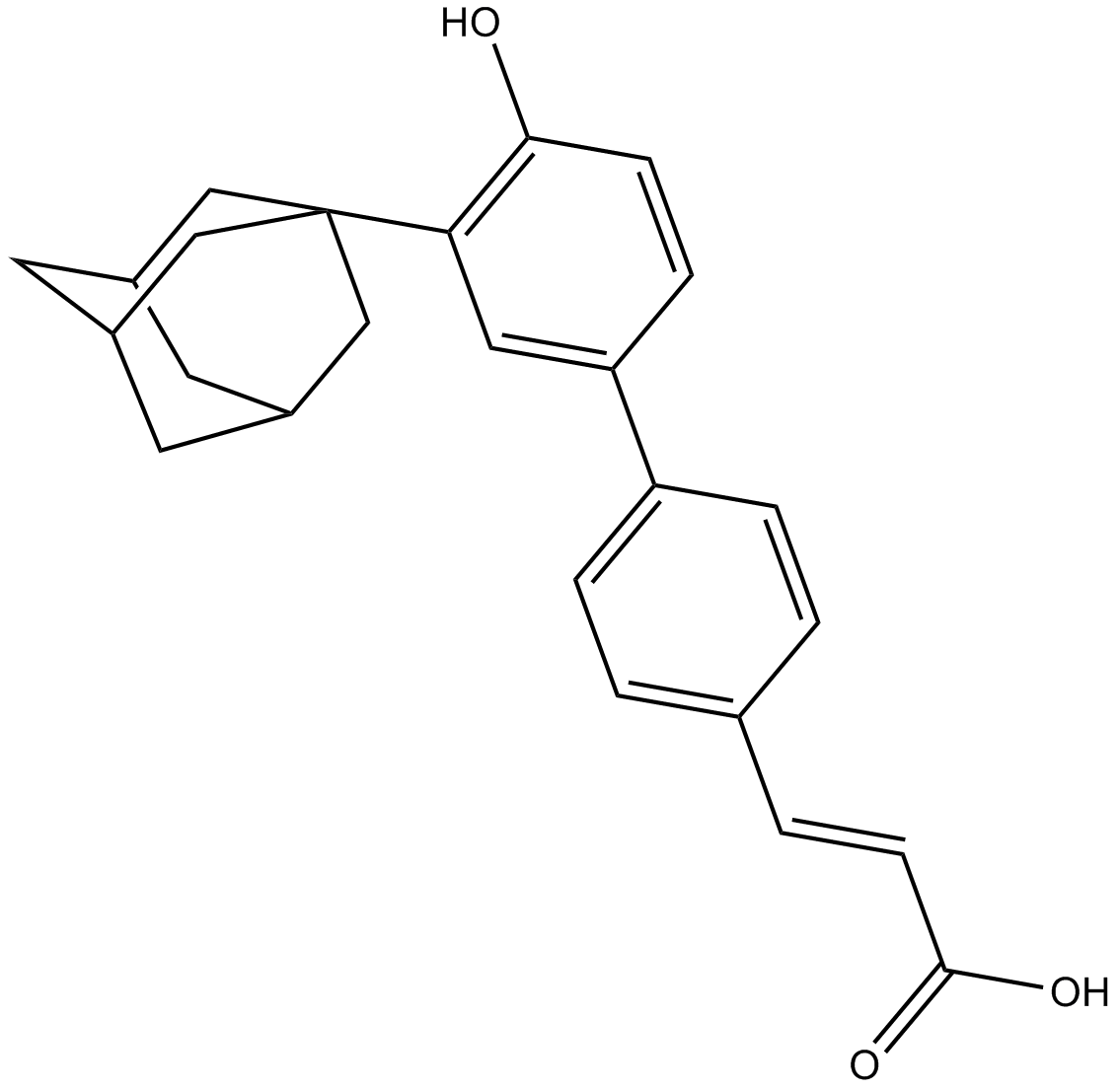
-
GC65880
ADH-6 TFA
ADH-6 TFA ist eine Tripyridylamid-Verbindung. ADH-6 hebt die Selbstorganisation der aggregationskernbildenden SubdomÄne von mutiertem p53 DBD auf. ADH-6 TFA zielt auf mutierte p53-Aggregate ab und dissoziiert sie in menschlichen Krebszellen, wodurch die TranskriptionsaktivitÄt von p53' wiederhergestellt wird, was zu Zellzyklusarrest und Apoptose fÜhrt. ADH-6 TFA hat das Potenzial fÜr die Erforschung von Krebserkrankungen.
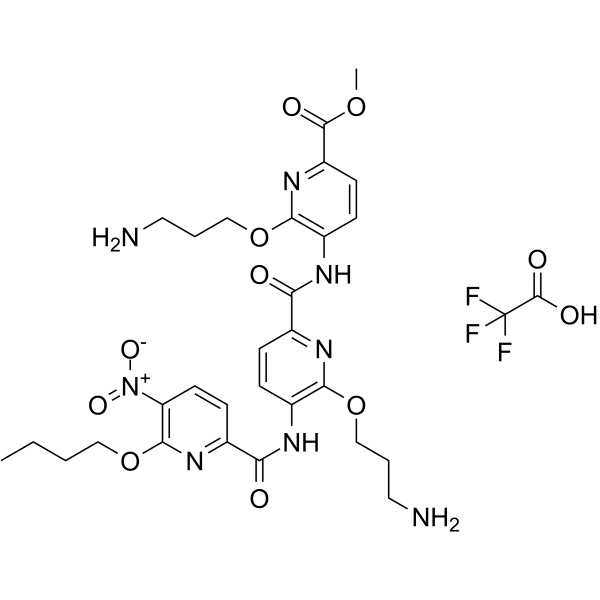
-
GC42735
Adipostatin A
Adipostatin A (Adipostatin A) ist ein Glycerol-3-Phosphat-Dehydrogenase (GPDH)-Inhibitor mit einem IC50-Wert von 4,1 μM.

-
GC11892
AEE788 (NVP-AEE788)
AEE788 (NVP-AEE788) ist ein Inhibitor von EGFR und ErbB2 mit IC50-Werten von 2 bzw. 6 nM.
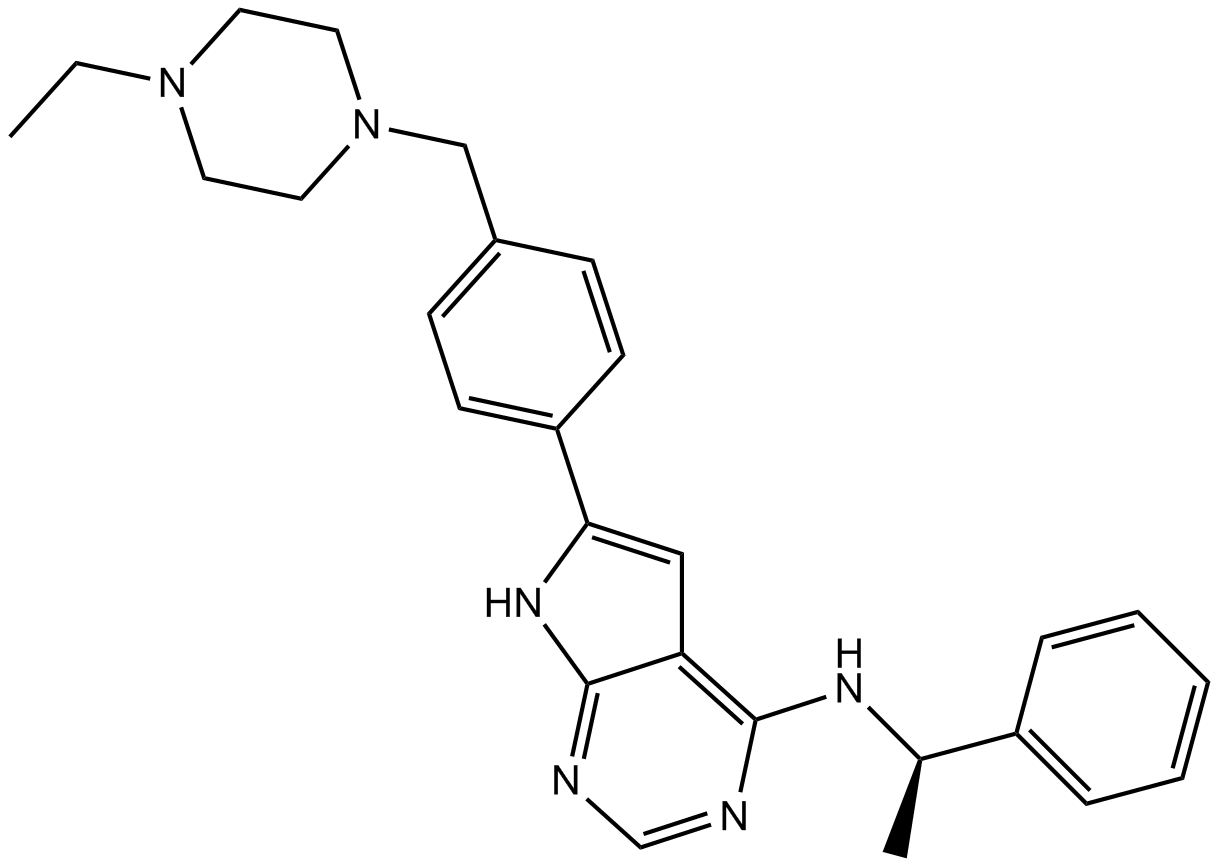
-
GC42743
AEM1
AEM1 ist ein Nrf2-Inhibitor. AEM1 reduziert die Expression von Nrf2-abhÄngigen Genen in A549-Zellen und hemmt das Wachstum von A549-Zellen in vitro und in vivo.

-
GC13168
AG 825
AG 825 (Tyrphostin AG 825) ist ein selektiver und ATP-kompetitiver ErbB2-Inhibitor, der die Tyrosinphosphorylierung unterdrückt, mit einem IC50 von 0,35 μM.
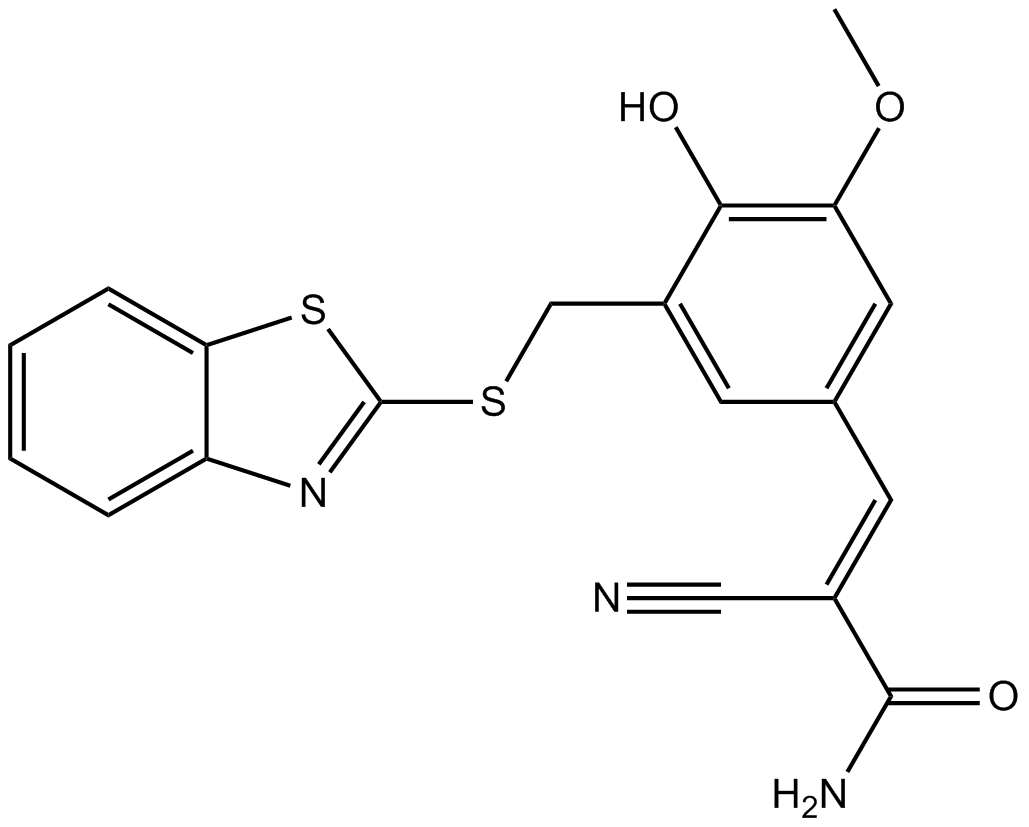
-
GC13697
AG-1024
AG-1024 (Tyrphostin AG 1024) ist ein reversibler, kompetitiver und selektiver IGF-1R-Inhibitor mit einem IC50 von 7 μM.
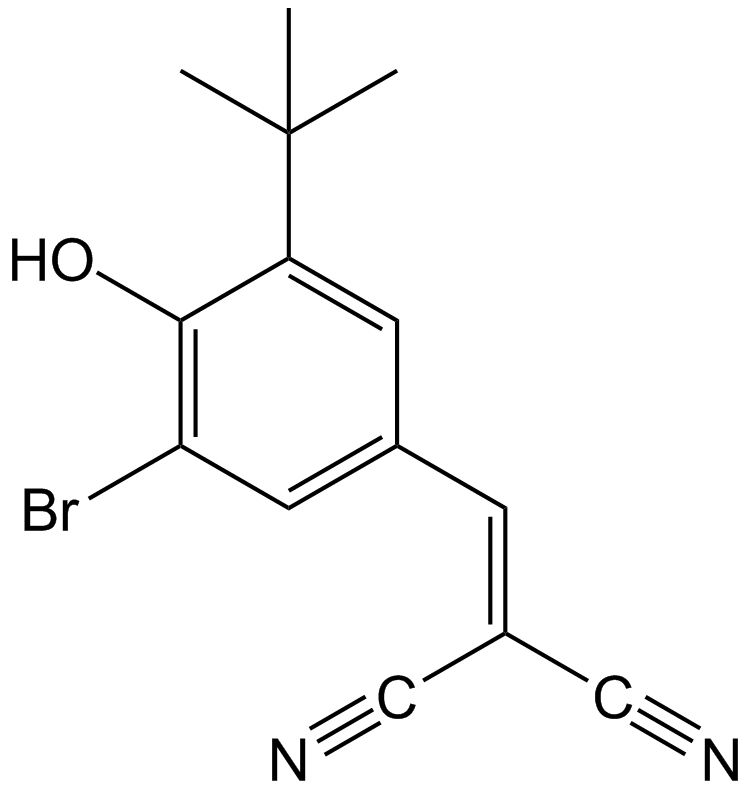
-
GC17881
AGK 2
AGK 2 ist ein selektiver SIRT2-Inhibitor mit einem IC50 von 3,5 μM. AGK 2 hemmt SIRT1 und SIRT3 mit IC50-Werten von 30 bzw. 91 μM.
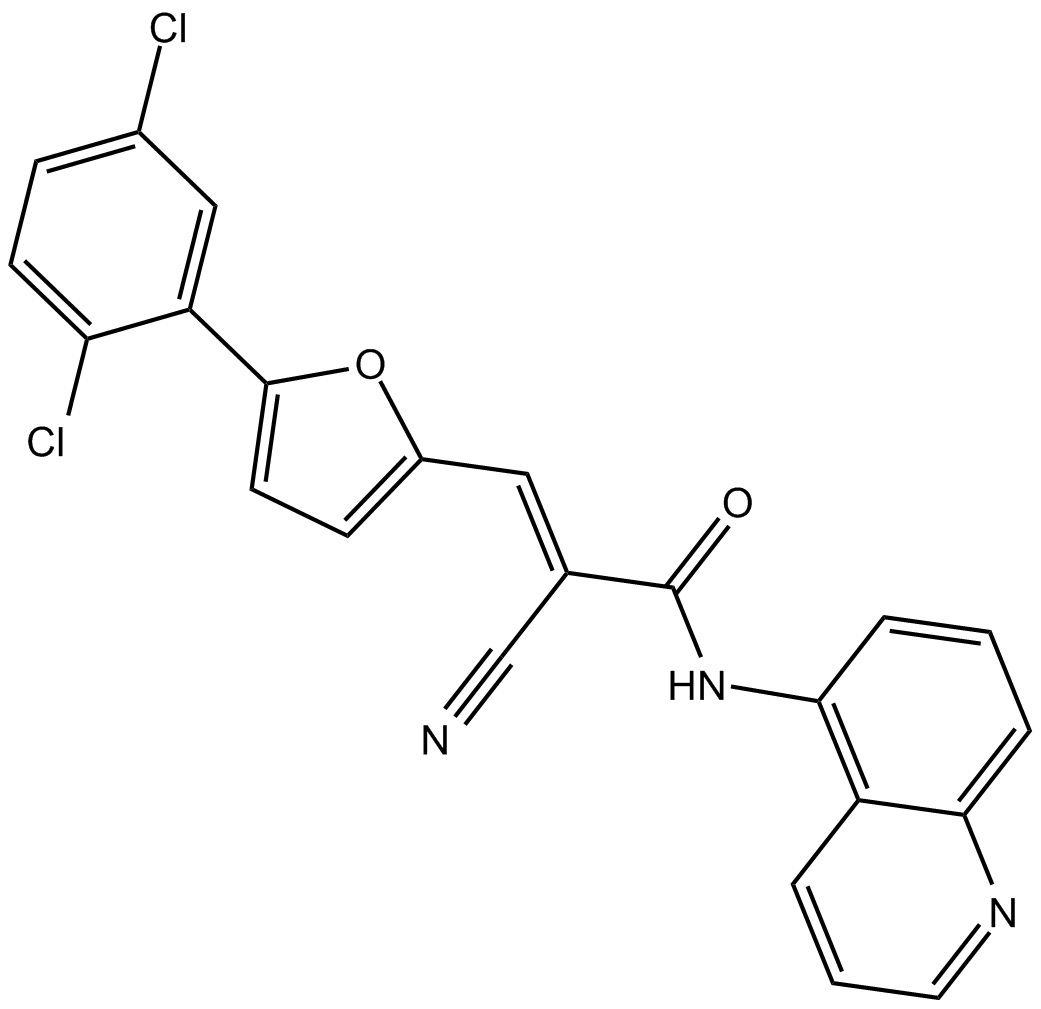
-
GC39584
AGN194204
AGN194204 (IRX4204) ist ein oral aktiver und selektiver RXR-Agonist mit Kd-Werten von 0,4 nM, 3,6 nM und 3,8 nM sowie EC50s von 0,2 nM, 0,8 nM und 0,08 nM für RXRα-, RXRβ- und RXRγ-Rezeptoren.
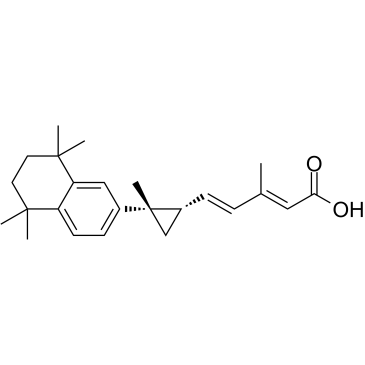
-
GC16120
AI-3
Nrf2/Keap1 and Keap1/Cul3 interaction inhibitor
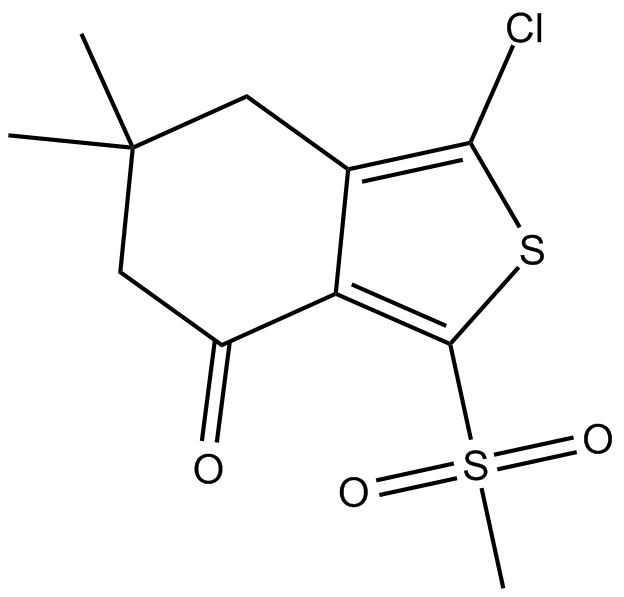
-
GC46821
Ajoene
Ajoene, eine aus Knoblauch gewonnene Verbindung, ist ein antithrombotisches und antimykotisches Mittel.

-
GC39620
AKOS-22
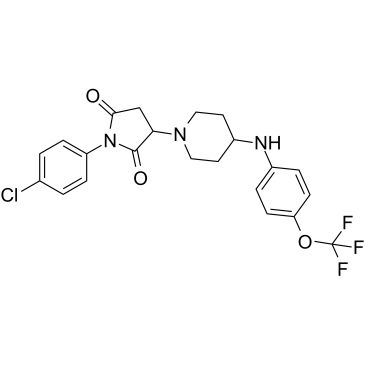
-
GC11589
AKT inhibitor VIII
A potent inhibitor of Akt1 and Akt2

-
GC35275
AKT-IN-3
AKT-IN-3 (Verbindung E22) ist ein potenter, oral aktiver Akt-Inhibitor mit niedrigem hERG-Wert, mit 1,4 nM, 1,2 nM und 1,7 nM fÜr Akt1, Akt2 bzw. Akt3. AKT-IN-3 (Verbindung E22) zeigt auch eine gute inhibitorische AktivitÄt gegenÜber anderen Kinasen der AGC-Familie, wie PKA, PKC, ROCK1, RSK1, P70S6K und SGK. AKT-IN-3 (Verbindung E22) induziert Apoptose und hemmt die Metastasierung von Krebszellen.
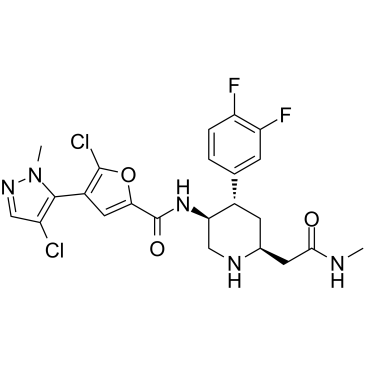
-
GC49773
Albendazole sulfone-d3
An internal standard for the quantification of albendazole sulfone

-
GC48848
Albendazole-d7
Albendazol-d7 (SKF-62979-d7) ist das mit Deuterium markierte Albendazol.

-
GC41080
Albofungin
Albofungin is a xanthone isolated from A.

-
GC16597
Alda 1
Alda 1 ist ein potenter und selektiver ALDH2-Agonist, der Wildtyp-ALDH2 aktiviert und ALDH2*2-ähnliche Wildtyp-Aktivität wiederherstellt.
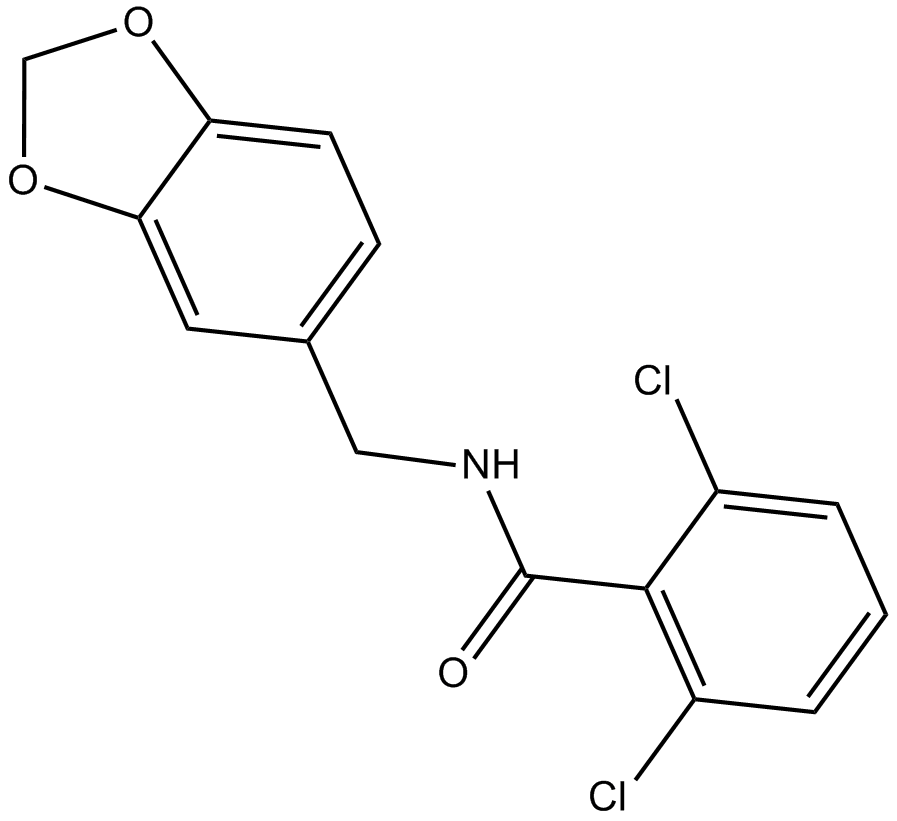
-
GC35288
Alkannin
Alkannin, das in Alkanna tinctoria vorkommt, wird als Lebensmittelfarbstoff verwendet.
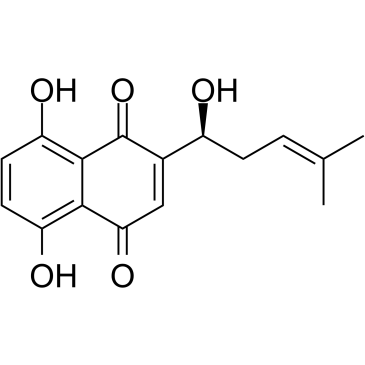
-
GC49393
all-trans-13,14-Dihydroretinol
A metabolite of all-trans retinoic acid

-
GC32127
Alofanib (RPT835)
Alofanib (RPT835) (RPT835) ist ein potenter und selektiver allosterischer Inhibitor des Fibroblasten-Wachstumsfaktor-Rezeptors 2 (FGFR2).

-
GC14314
Aloperine
Aloperin ist ein Alkaloid in Sophora-Pflanzen wie Sophora alopecuroides L, das krebshemmende, entzÜndungshemmende und antivirale Eigenschaften gezeigt hat.
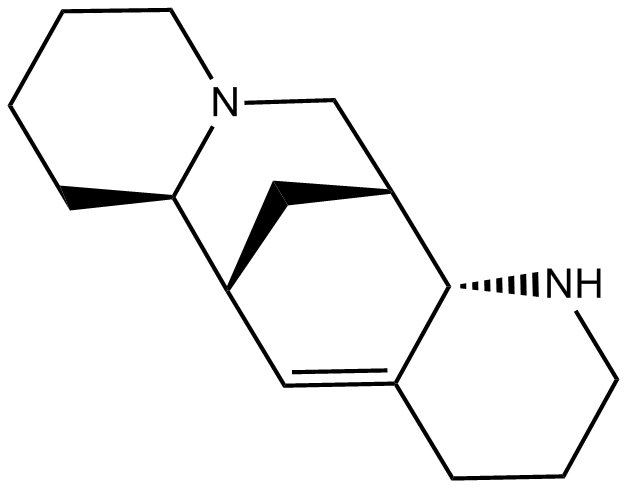
-
GC35306
alpha-Mangostin
Alpha-Mangostin (α-Mangostin) ist ein diÄtetisches Xanthon mit breiten biologischen AktivitÄten, wie z. B. antioxidative, antiallergische, antivirale, antibakterielle, entzÜndungshemmende und krebshemmende Wirkungen. Es ist ein Inhibitor der mutierten IDH1 (IDH1-R132H) mit einem Ki von 2,85 μM.
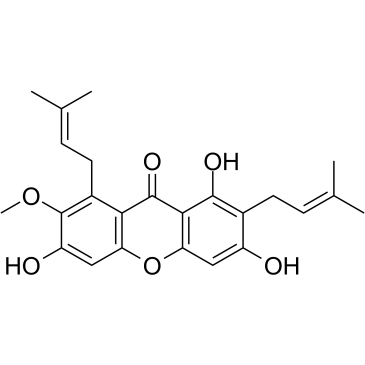
-
GC18437
Alternariol monomethyl ether
Alternariolmonomethylether, isoliert aus den Wurzeln von Anthocleista djalonensis (Loganiaceae), ist ein wichtiger taxonomischer Marker der Pflanzenart.
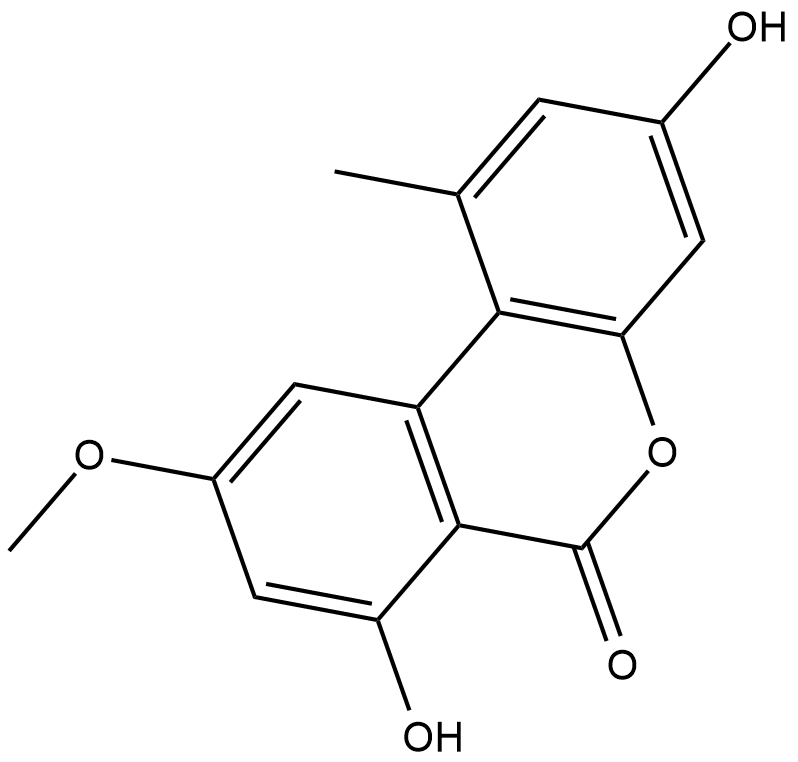
-
GC33356
AM-8735
AM-8735 ist ein potenter und selektiver MDM2-Inhibitor mit einem IC50 von 25 nM.
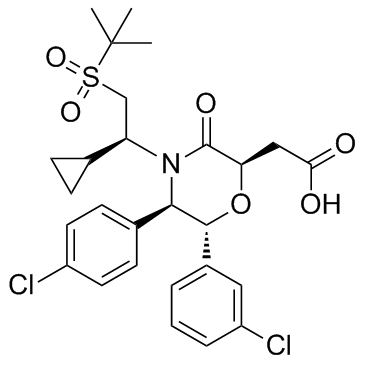
-
GC42776
Amarogentin
Amarogentin ist ein Secoiridoid-Glykosid, das hauptsÄchlich aus Swertia- und Gentiana-Wurzeln gewonnen wird.

-
GN10484
Amentoflavone
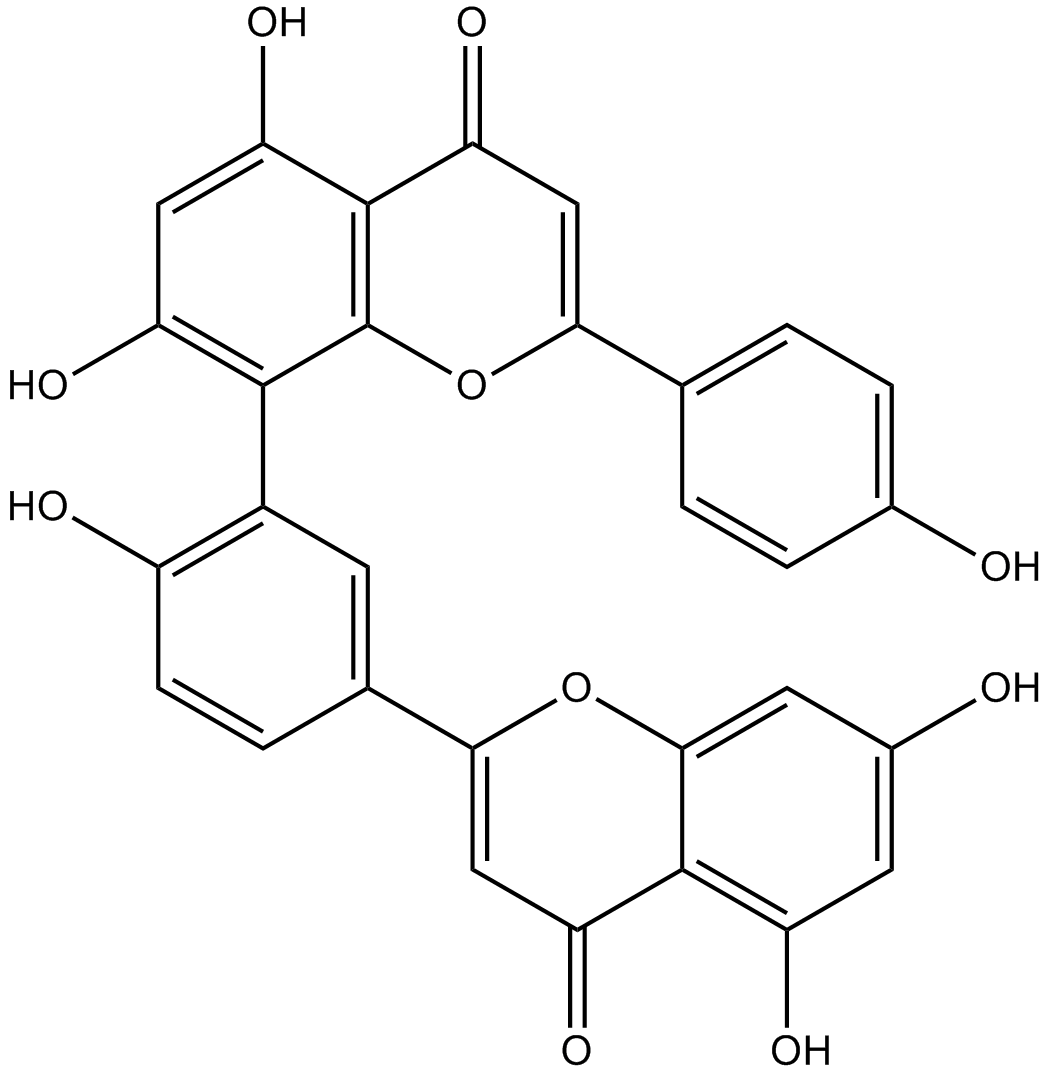
-
GC42783
Ametantrone
Ametantron (NSC 196473) ist ein Antitumormittel, das in DNA interkaliert und einen durch Topoisomerase II (TOP2) vermittelten DNA-Bruch induziert.

-
GC19452
AMG-176
AMG-176, bekannt als Tapotoclax, zeichnet sich als ein starker, selektiver und oral verfügbarer Inhibitor von MCL-1 aus, mit einem Ki-Wert von 0,13 nM.
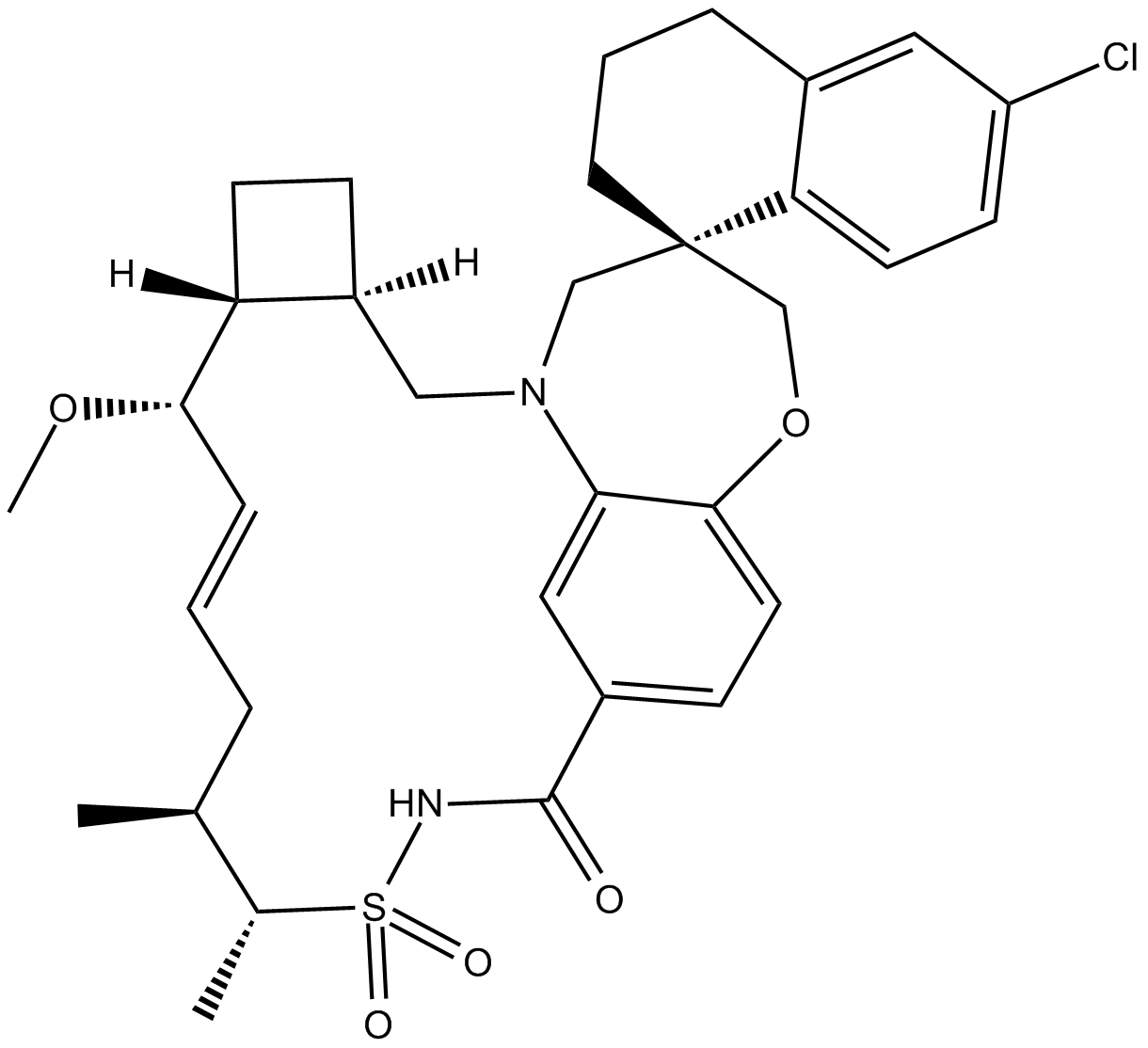
-
GC15828
AMG232
AMG232 (AMG 232) ist ein potenter, selektiver und oral verfÜgbarer Inhibitor der p53-MDM2-Interaktion mit einem IC50 von 0,6 nM. AMG232 bindet an MDM2 mit einem Kd von 0,045 nM.
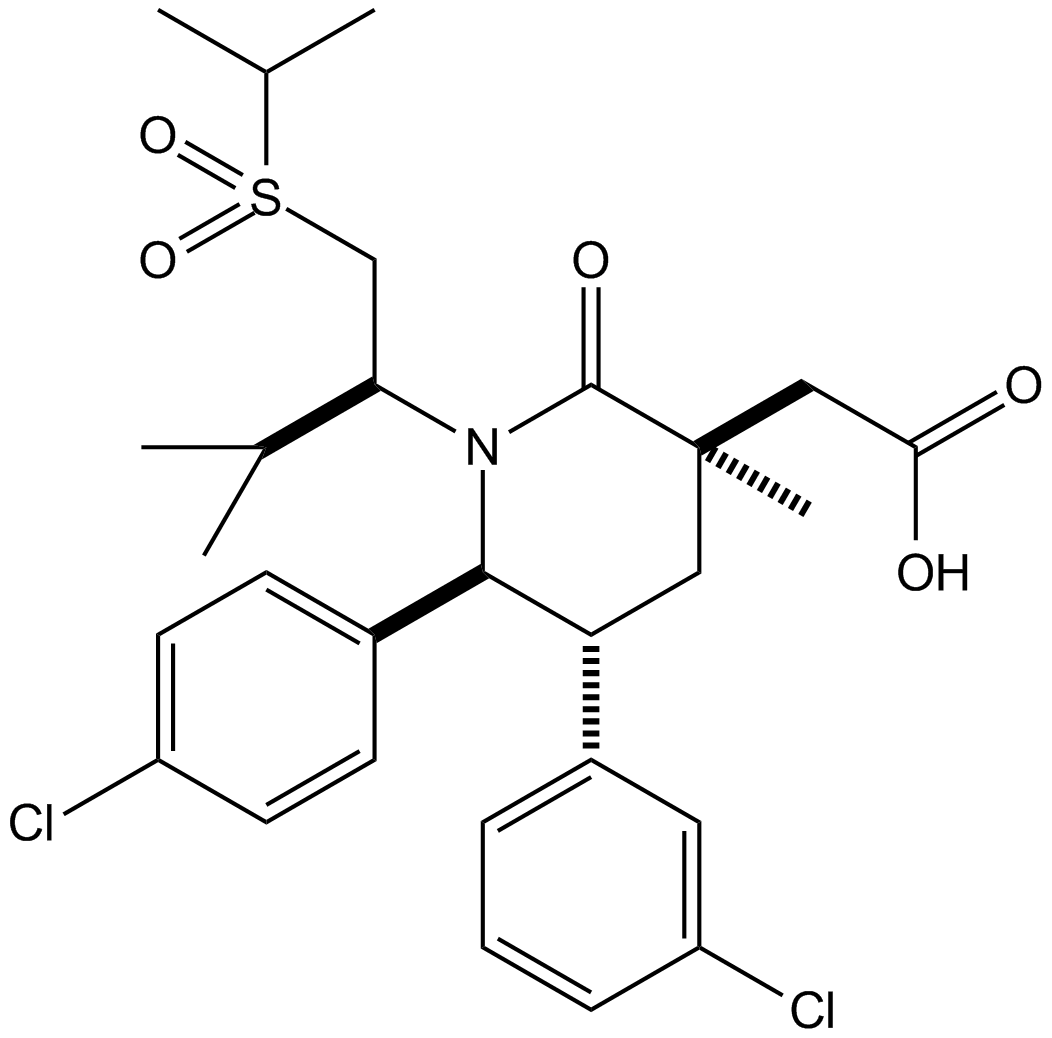
-
GC42785
Amifostine (hydrate)
Amifostin (Hydrat) (WR2721-Trihydrat) ist ein Breitspektrum-Zellschutzmittel und ein Strahlenschutzmittel. Amifostin (Hydrat) schÜtzt selektiv normales Gewebe vor SchÄden durch Bestrahlung und Chemotherapie. Amifostin (Hydrat) ist ein potenter Hypoxie-induzierbarer Faktor-α1 (HIF-α1) und p53-Induktor. Amifostin (Hydrat) schÜtzt Zellen vor SchÄden, indem es freie Radikale aus Sauerstoff abfÄngt. Amifostin (Hydrat) reduziert die NierentoxizitÄt und hat eine antiangiogene Wirkung.

-
GC61804
Amifostine thiol
Amifostin-Thiol (WR-1065) ist ein aktiver Metabolit des Zytoprotektors Amifostin. Amifostin-Thiol ist ein zytoprotektives Mittel mit radioprotektiven FÄhigkeiten. Amifostin-Thiol aktiviert p53 Über einen JNK-abhÄngigen Signalweg.
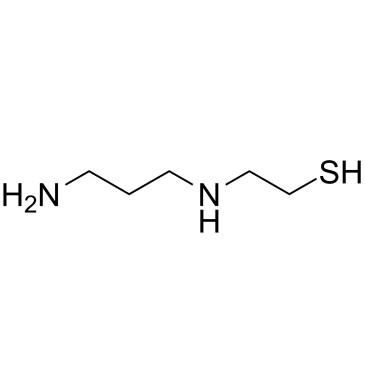
-
GC12051
Amiloride HCl dihydrate
Amilorid-HCl-Dihydrat (MK-870-Hydrochlorid-Dihydrat) ist ein Inhibitor sowohl des epithelialen Natriumkanals (ENaC[1]) als auch des Plasminogen-Aktivator-Rezeptors vom Urokinase-Typ (uTPA[2]).
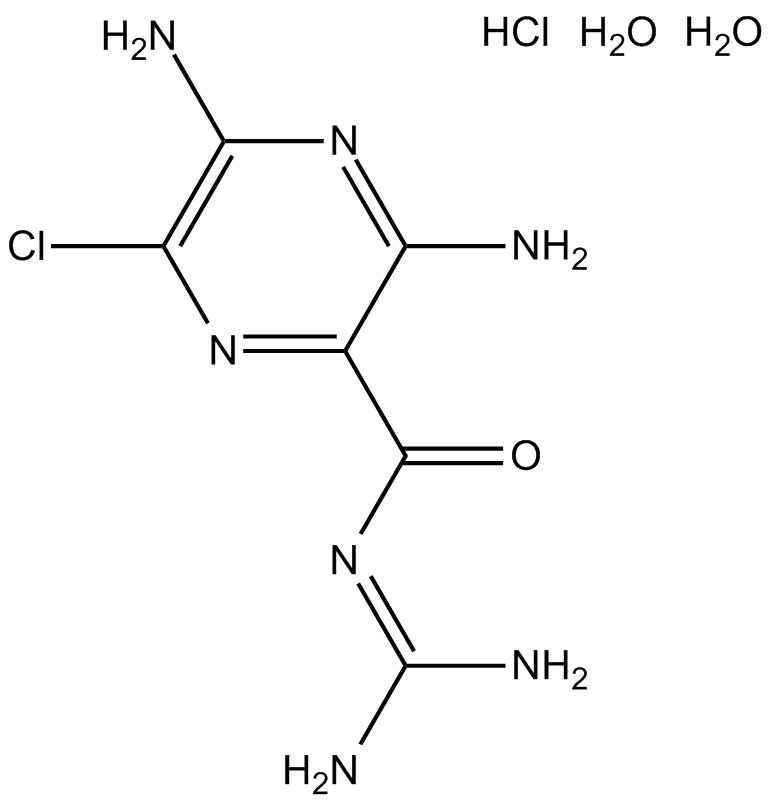
-
GC63932
Amsilarotene
Amsilarotene (TAC-101; Am 555S), ein oral aktives synthetisches Retinoid, hat eine selektive AffinitÄt zum RetinsÄurerezeptor α (RAR-α) Bindung mit Ki von 2,4, 400 nM fÜr RAR-α und RAR-β. Amsilaroten induziert die Apoptose menschlicher Magenkrebs-, hepatozellulÄrer Karzinom- und Ovarialkarzinomzellen. Amsilarotene kann fÜr die Krebsforschung verwendet werden.
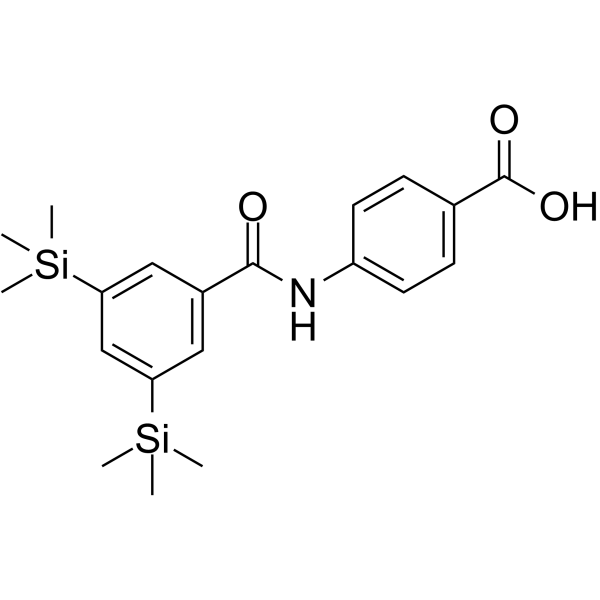
-
GC16391
Amuvatinib (MP-470, HPK 56)
A multi-targeted RTK inhibitor
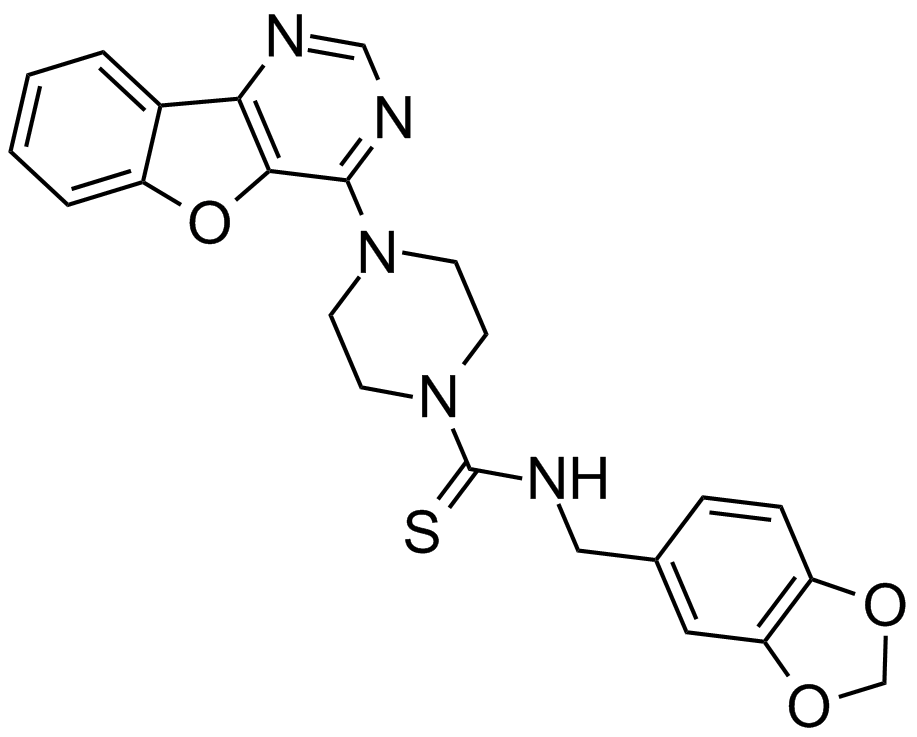
-
GC48339
Amycolatopsin A
A macrolide polyketide with antimycobacterial and anticancer activities

-
GC48341
Amycolatopsin B
A bacterial metabolite

-
GC48350
Amycolatopsin C
A polyketide macrolide with antimycobacterial and anticancer activities

-
GC42806
Andrastin A
Andrastin A is a meroterpenoid farnesyltransferase inhibitor.

-
GN10045
Angelicin
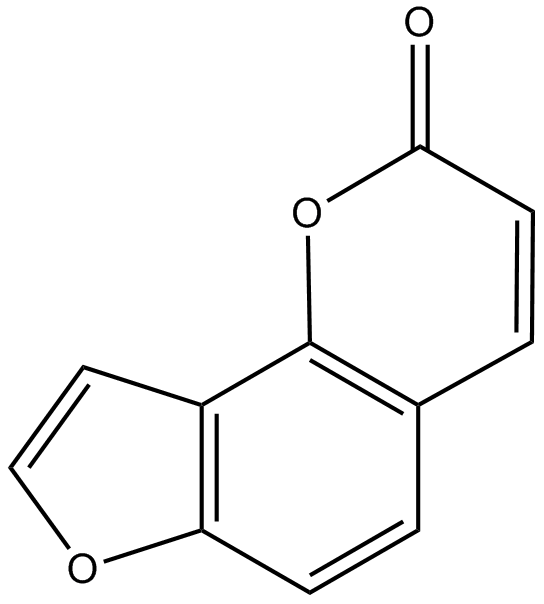
-
GC60584
Angiotensin II human acetate
Angiotensin II human (Angiotensin II) Acetat ist ein Vasokonstriktor und ein wichtiges bioaktives Peptid des Renin/Angiotensin-Systems.
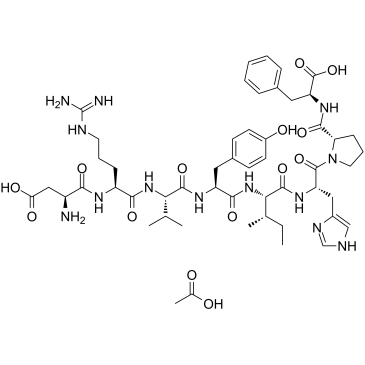
-
GC42813
Anguinomycin A
Anguinomycin A is an antibiotic first isolated from a Streptomyces sp.

-
GC40614
Anhydroepiophiobolin A
Anhydroepiophiobolin A, ein Analogon von Ophiobolin A, ist ein potenter Inhibitor der Photosynthese (I50s von 6,1 und 1 mM fÜr die Photosynthese in Chlorella bzw. Spinat).

-
GC40214
Anhydroophiobolin A
Anhydroophiobolin A ist ein potenter Inhibitor der Photosynthese mit IC50-Werten von 77 bzw. 14 mM bei der Photosynthese von Chlorella bzw. Spinat.

-
GC11559
Anisomycin
JNK-Agonist, stark und spezifisch.
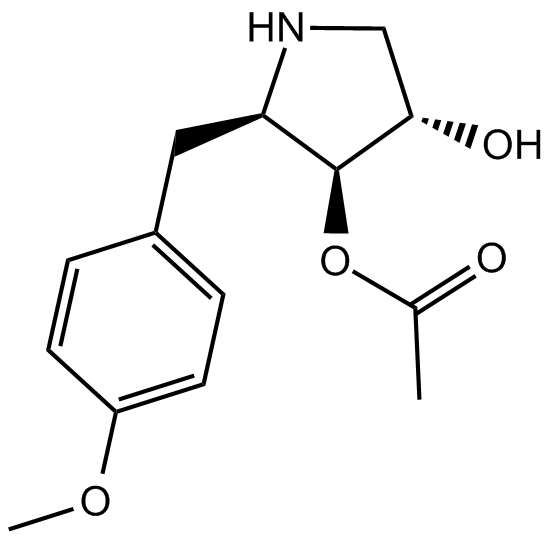
-
GC49259
Antagonist G (trifluoroacetate salt)
A neuropeptide antagonist

-
GC66337
Anti-Mouse PD-L1 Antibody
Anti-Maus-PD-L1-AntikÖrper ist ein Anti-Maus-PD-L1-IgG2b-AntikÖrper-Inhibitor, der aus der Wirtsratte stammt.
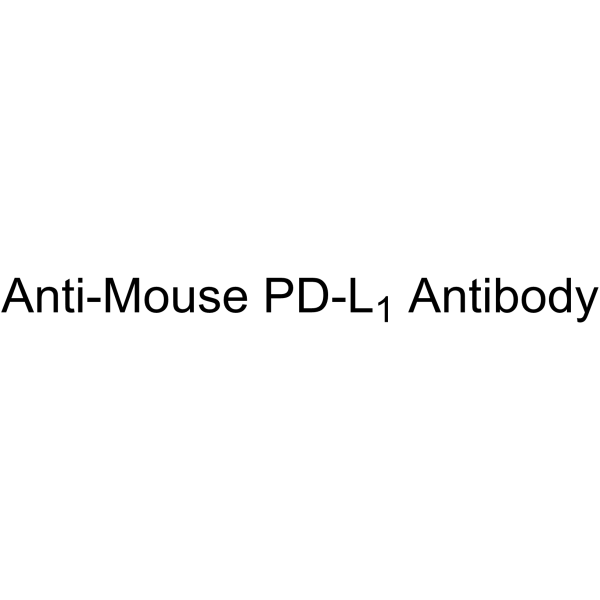
-
GC35361
Antineoplaston A10
Antineoplaston A10, eine natÜrlich im menschlichen KÖrper vorkommende Substanz, ist ein Ras-Inhibitor, der potenziell zur Behandlung von Gliom, Lymphom, Astrozytom und Brustkrebs eingesetzt werden kann.
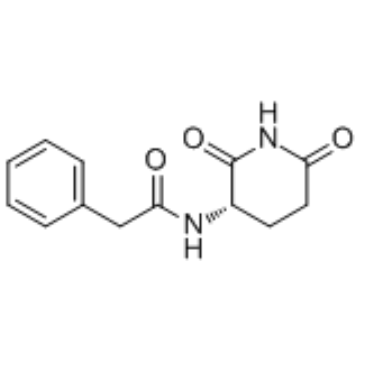
-
GC34172
AP1867
AP1867 ist ein synthetischer FKBP12F36V-gerichteter Ligand.
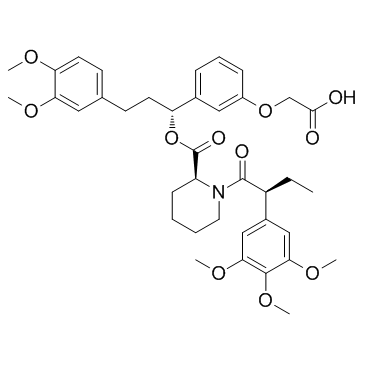
-
GC61745
AP1867-2-(carboxymethoxy)
AP1867-2-(Carboxymethoxy), die auf AP1867 (einem synthetischen, auf FKBP12F36V gerichteten Liganden) basierende Einheit, bindet Über einen Linker an den CRBN-Liganden, um dTAG-MolekÜle zu bilden.

-
GC15586
AP1903
AP1903 (AP1903) ist ein Dimerisierungsmittel, das durch Quervernetzung der FKBP-DomÄnen wirkt. AP1903 (AP1903) dimerisiert den Caspase 9 Selbstmordschalter und induziert schnell Apoptose.
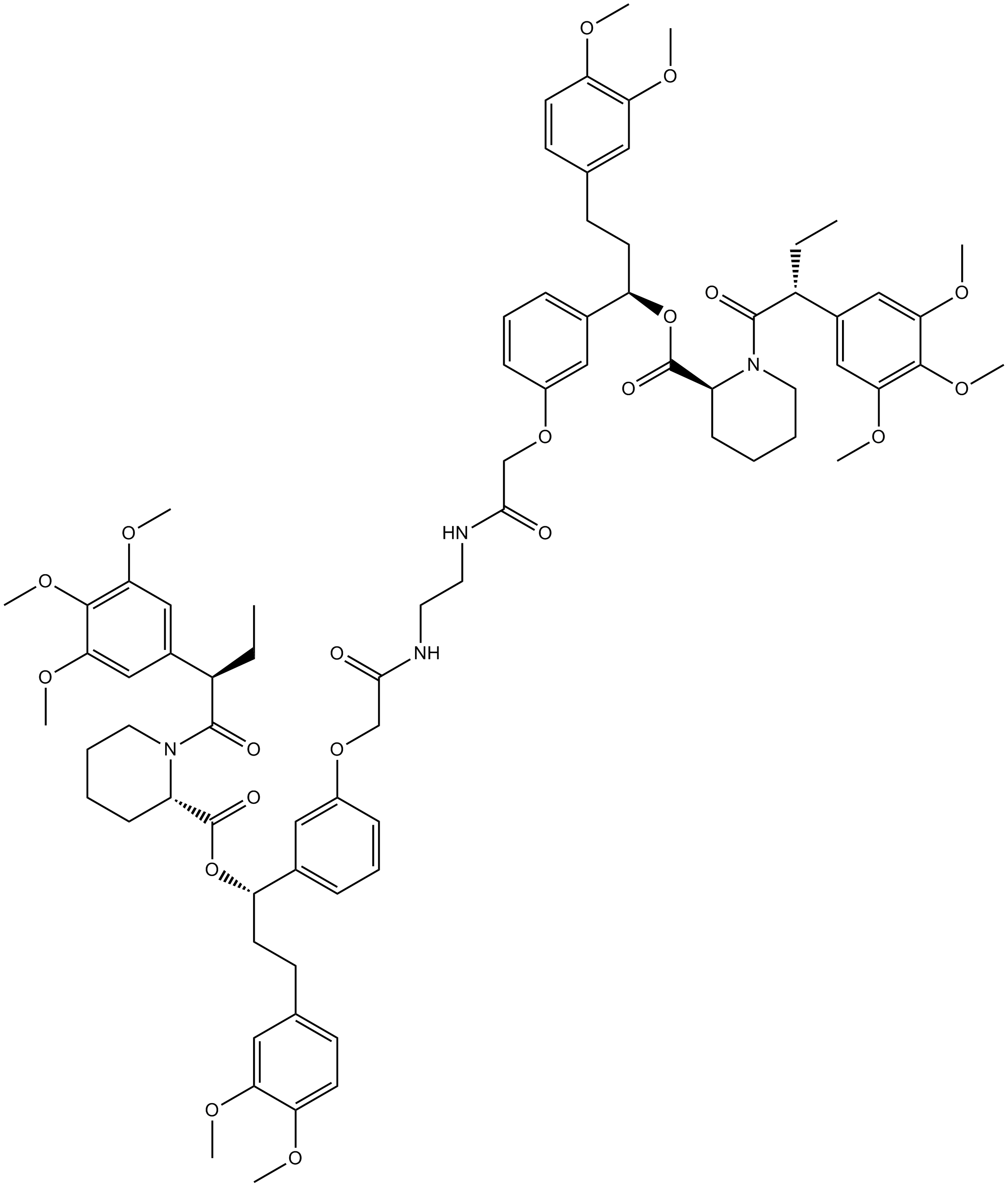
-
GC14498
AP20187
AP20187 (B/B Homodimerizer) ist ein zelldurchlÄssiger Ligand, der zur Dimerisierung von FK506-Bindungsprotein (FKBP)-Fusionsproteinen und zur Initiierung biologischer Signalkaskaden und Genexpression oder zur Unterbrechung von Protein-Protein-Wechselwirkungen verwendet wird.
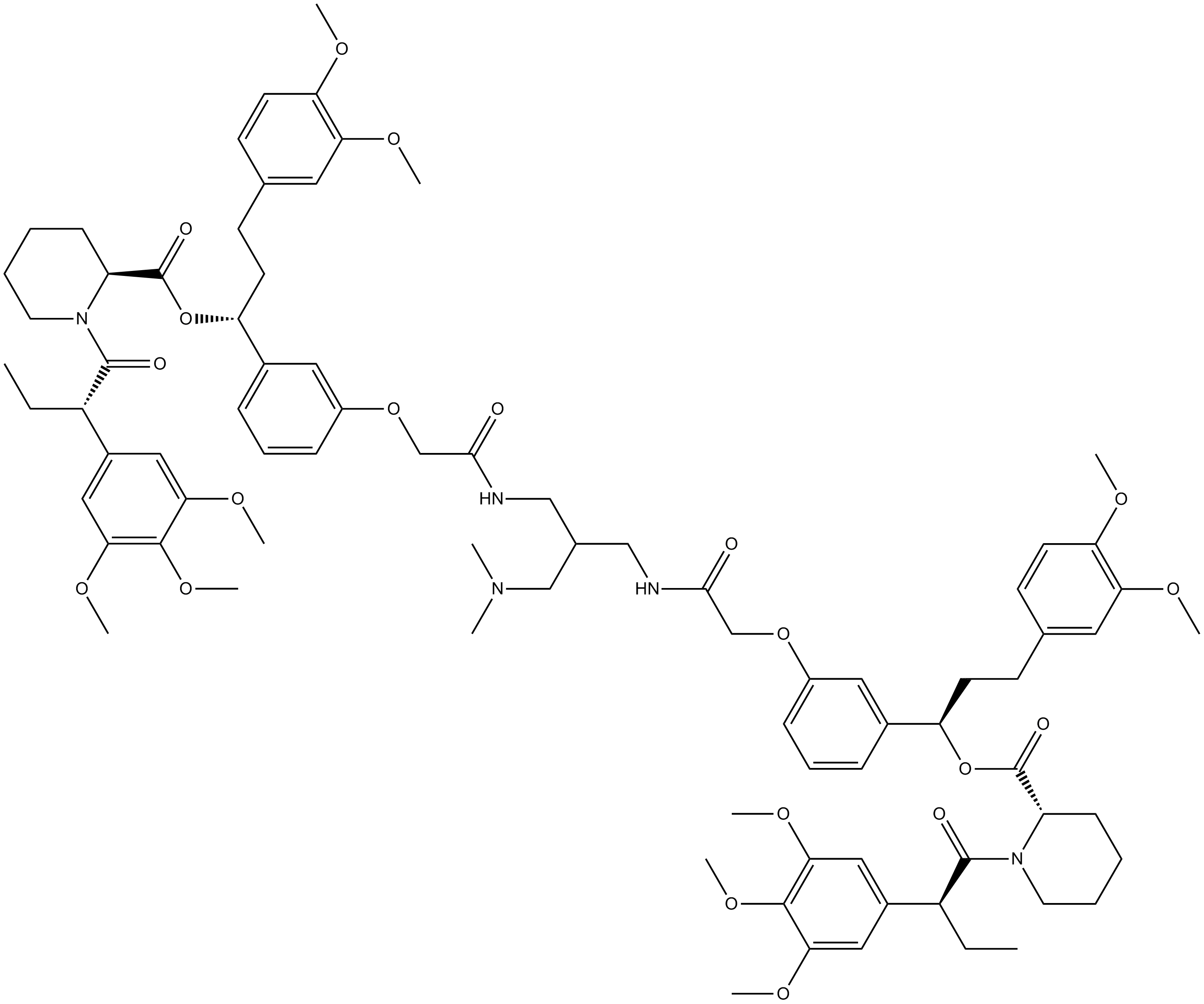
-
GC18518
Apcin
Apcin, ein Ligand von Cdc20, ist ein potenter und kompetitiver Anaphase-fÖrdernder Komplex/Cyclosom (APC/C(Cdc20))-E3-Ligase-AktivitÄtsinhibitor. Apcin hemmt kompetitiv die APC/C-abhÄngige Ubiquitinierung, indem es an Cdc20 bindet und die Substraterkennung verhindert. Apcin besetzt die D-Box-Bindungstasche auf der SeitenflÄche der WD40-DomÄne und kann die Mitose verlÄngern.
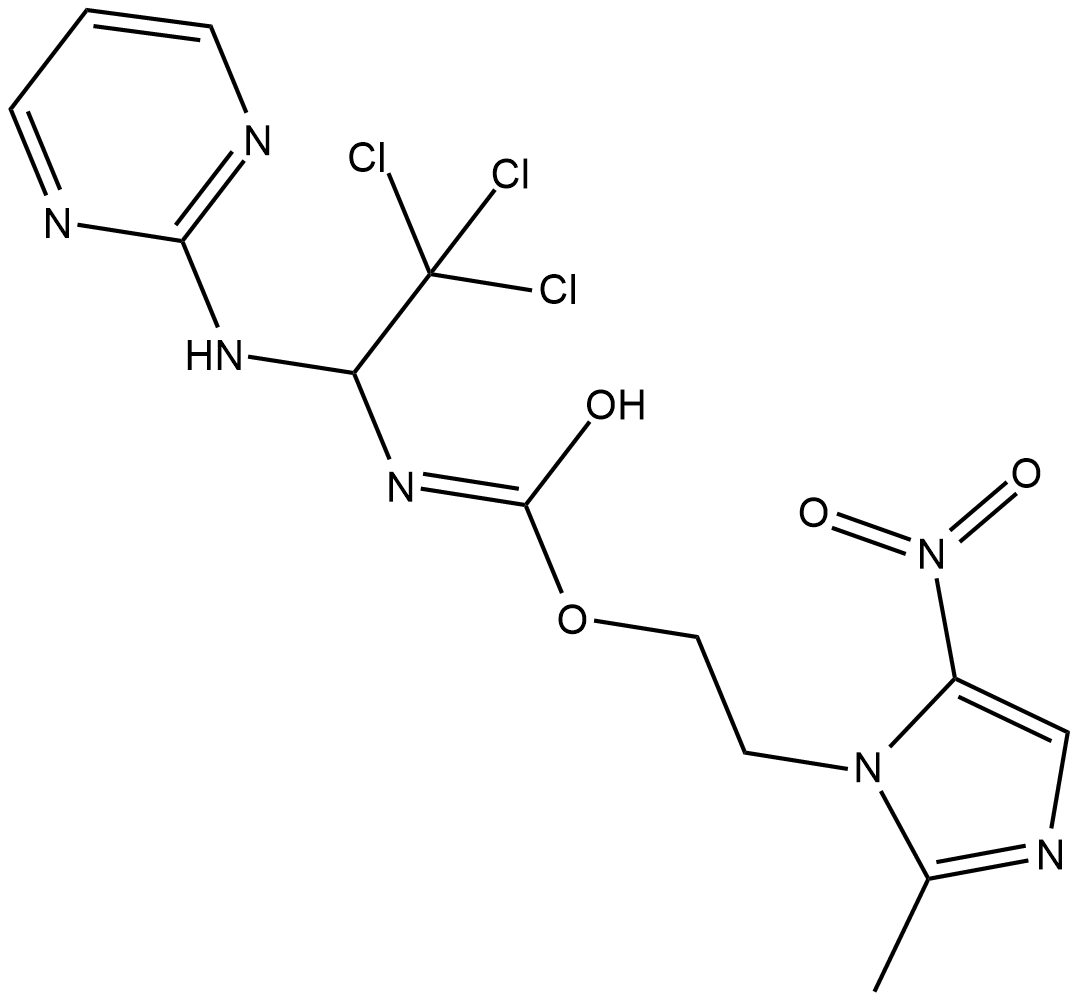
-
GC62419
Apcin-A
Apcin-A, ein Apcin-Derivat, ist ein Inhibitor des Anaphase-fÖrdernden Komplexes (APC). Apcin-A interagiert stark mit Cdc20 und hemmt die Ubiquitinierung von Cdc20-Substraten. Apcin-A kann verwendet werden, um das PROTAC CP5V zu synthetisieren.
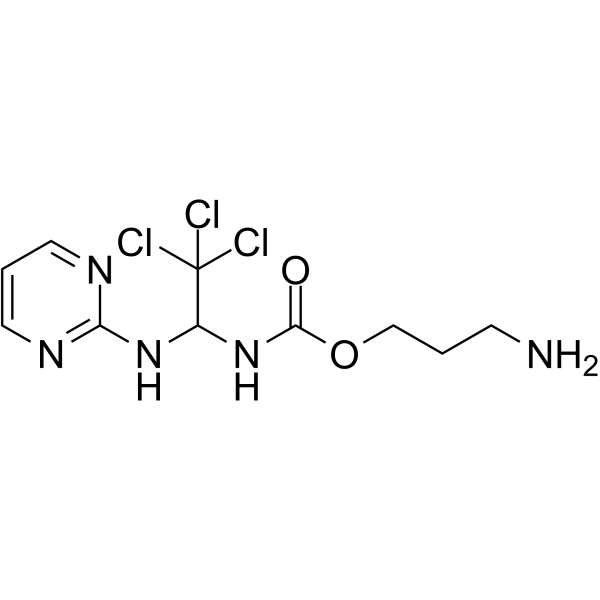
-
GC35367
APG-115
APG-115 (APG-115) ist ein oral aktiver MDM2-Protein-Inhibitor, der an das MDM2-Protein mit IC50- und Ki-Werten von 3,8 nM bzw. 1 nM bindet. APG-115 blockiert die Interaktion von MDM2 und p53 und induziert auf p53-abhÄngige Weise Zellzyklusarrest und Apoptose.
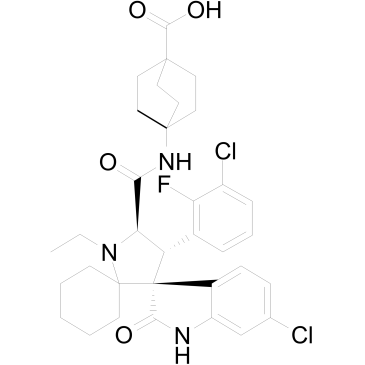
-
GC62640
APG-1387
APG-1387, ein bivalentes SMAC-Mimetikum und ein IAP-Antagonist, blockiert die AktivitÄt von Proteinen der IAP-Familie (XIAP, cIAP-1, cIAP-2 und ML-IAP). APG-1387 induziert den Abbau von cIAP-1- und XIAP-Proteinen sowie die Caspase-3-Aktivierung und die PARP-Spaltung, was zur Apoptose fÜhrt. APG-1387 kann fÜr die Erforschung von hepatozellulÄrem Karzinom, Eierstockkrebs und Nasopharynxkarzinom verwendet werden.
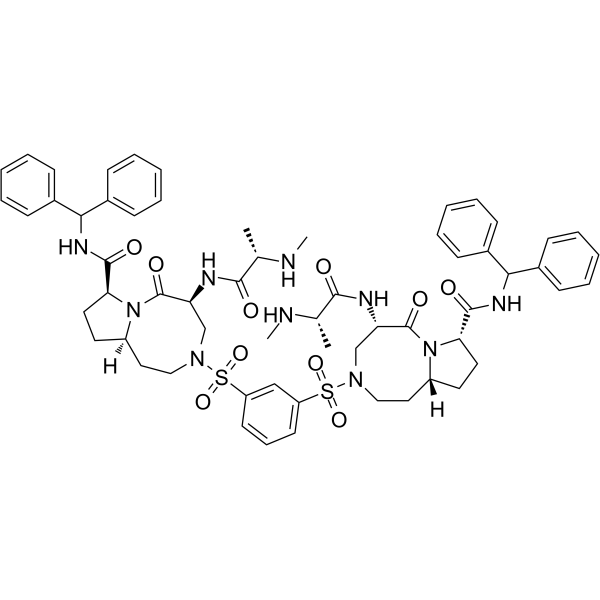
-
GC12961
Apicidin
Ein HDAC-Inhibitor, der die Zellmembran durchdringen kann.
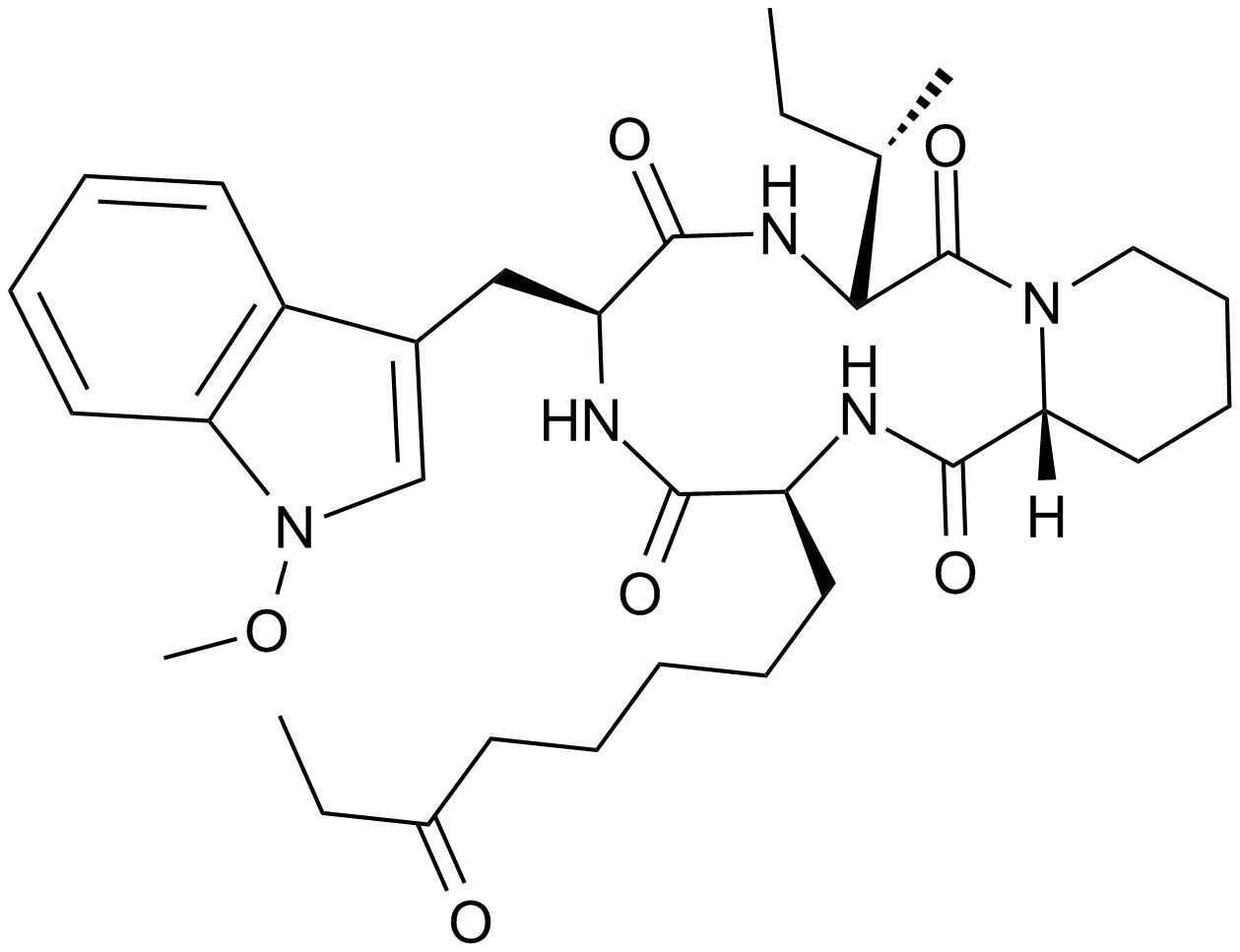
-
GC46862
Apigenin-d5
An internal standard for the quantification of apigenin

-
GC16237
Apocynin
Apocynin ist ein selektiver NADPH-Oxidase-Hemmer mit einem IC50 von 10 μM.
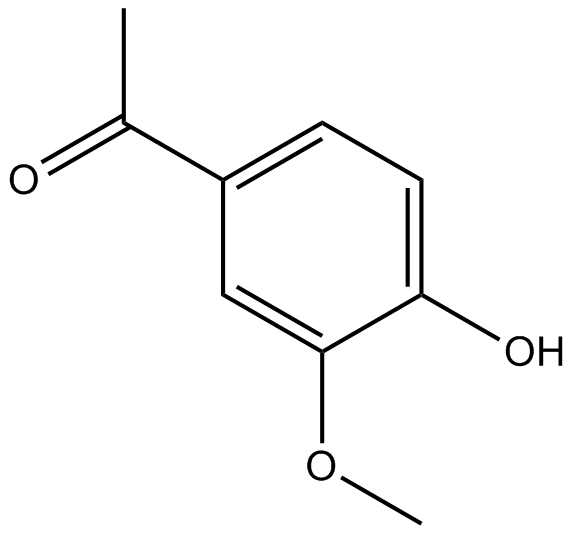
-
GC14080
Apogossypolone (ApoG2)
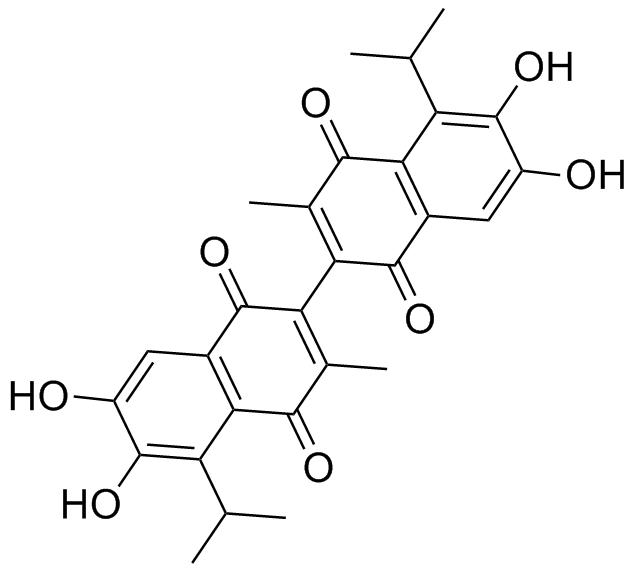
-
GC42827
Apoptolidin
Apoptolidin ist ein aus Nocardiopsis-Bakterien isoliertes Polyketid. Apoptolidin ist ein selektiver mitochondrialer F1FO-ATPase-Inhibitor. Apoptolidin ist ein Apoptoseinduktor und induziert den apoptotischen Zelltod in Zellen, die mit den Onkogenen des Adenovirus Typ 12 transformiert wurden, einschließlich ElA (IC50 = 10-17 ng/ml), aber nicht in normalen Zellen.

-
GC14209
Apoptosis Activator 2
An activator of caspases
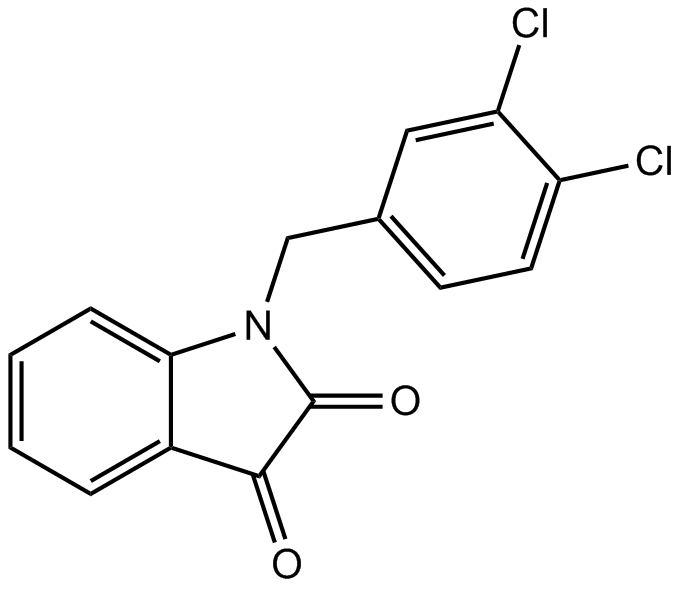
-
GC14411
Apoptozole
Apoptozol (Apoptose-Aktivator VII) ist ein Inhibitor der ATPase-DomÄne von Hsc70 und Hsp70 mit Kds von 0,21 bzw. 0,14 μM und kann Apoptose induzieren.
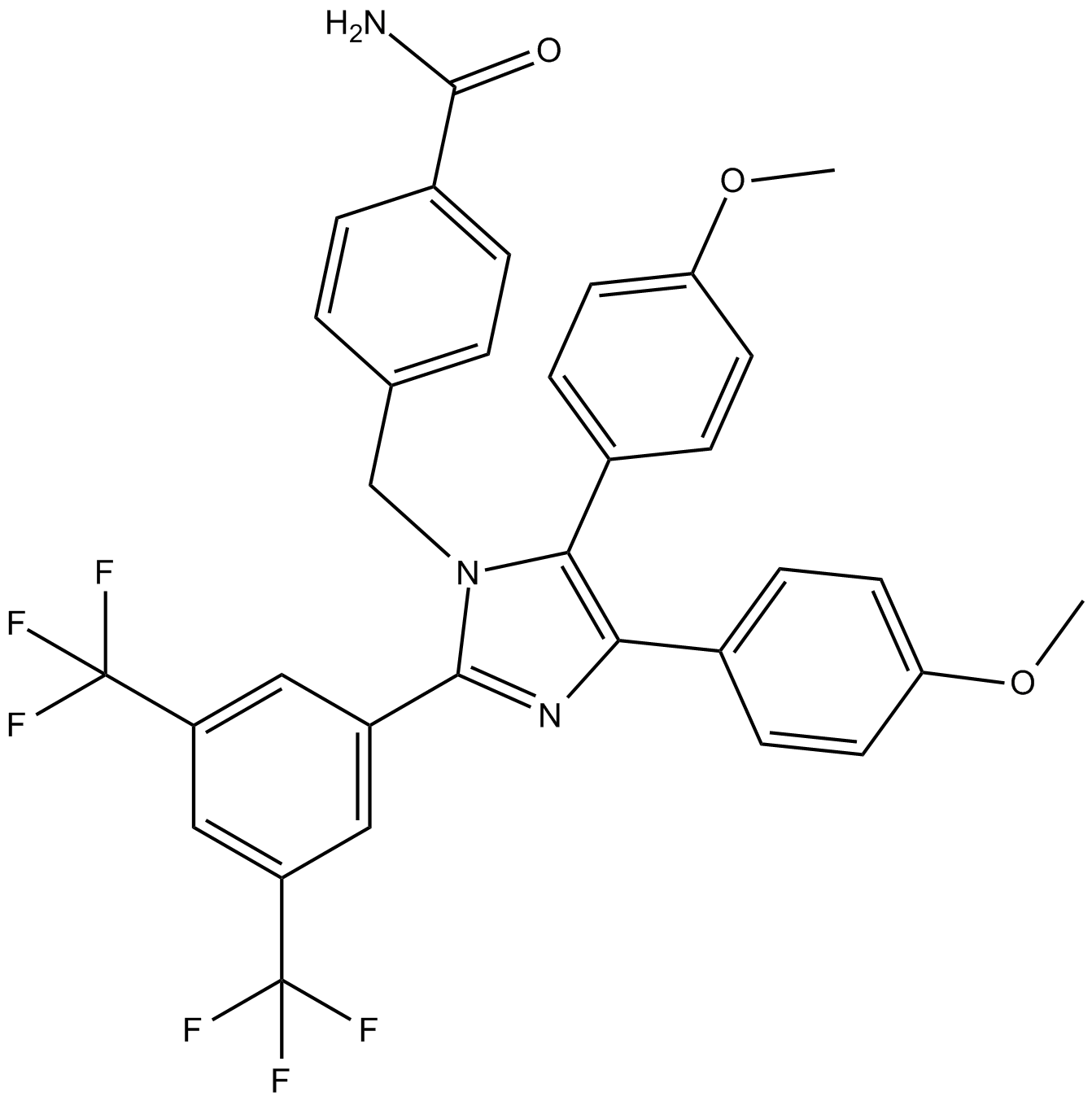
-
GC65004
Apostatin-1
Apostatin-1 (Apt-1) ist ein potenter TRADD-Hemmer.
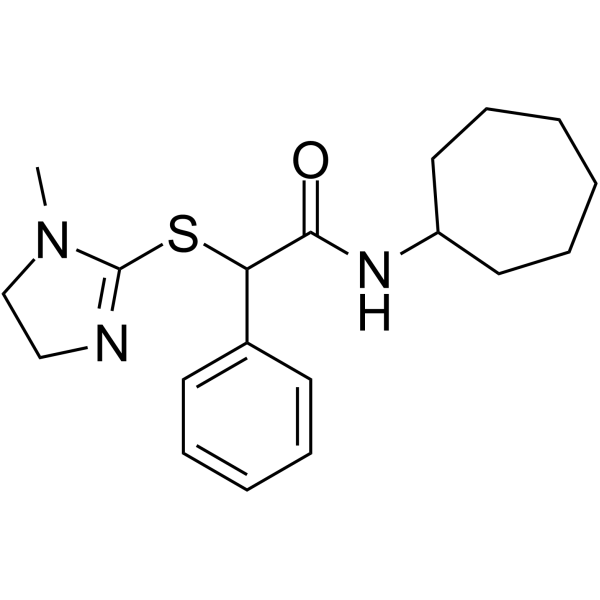
-
GC35377
Apratastat
Apratastat (TMI-005) ist ein oral aktiver, nicht selektiver und reversibler TACE/MMPs-Hemmer, der die Freisetzung von TNF-α hemmen kann. Apratastat hat das Potenzial, die Strahlentherapieresistenz bei nicht-kleinzelligem Lungenkrebs (NSCLC) zu Überwinden.
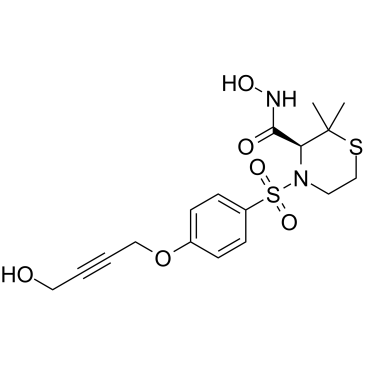
-
GC10420
Apremilast (CC-10004)
An orally available PDE4 inhibitor
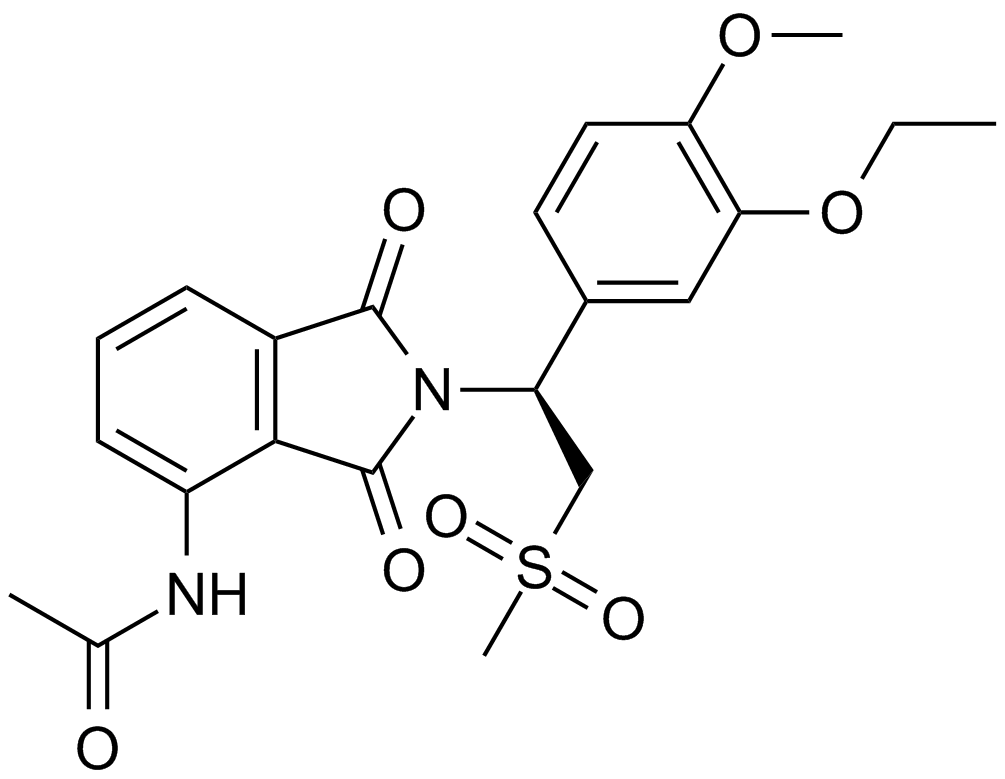
-
GC32692
APTO-253 (LOR-253)
APTO-253 ist eine neuartige Verbindung, die durch die Induktion der Expression des Master-Transkriptionsfaktors Kruppel-like factor 4 (KLF4) eine starke antitumorale Wirkung zeigt und den Zellzyklus hemmt, was zum programmierten Zelltod führt.
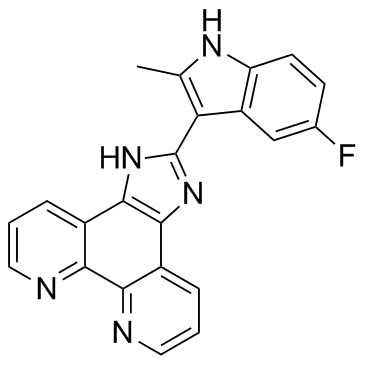
-
GC14590
AR-42 (OSU-HDAC42)
HDAC inhibitor,novel and potent
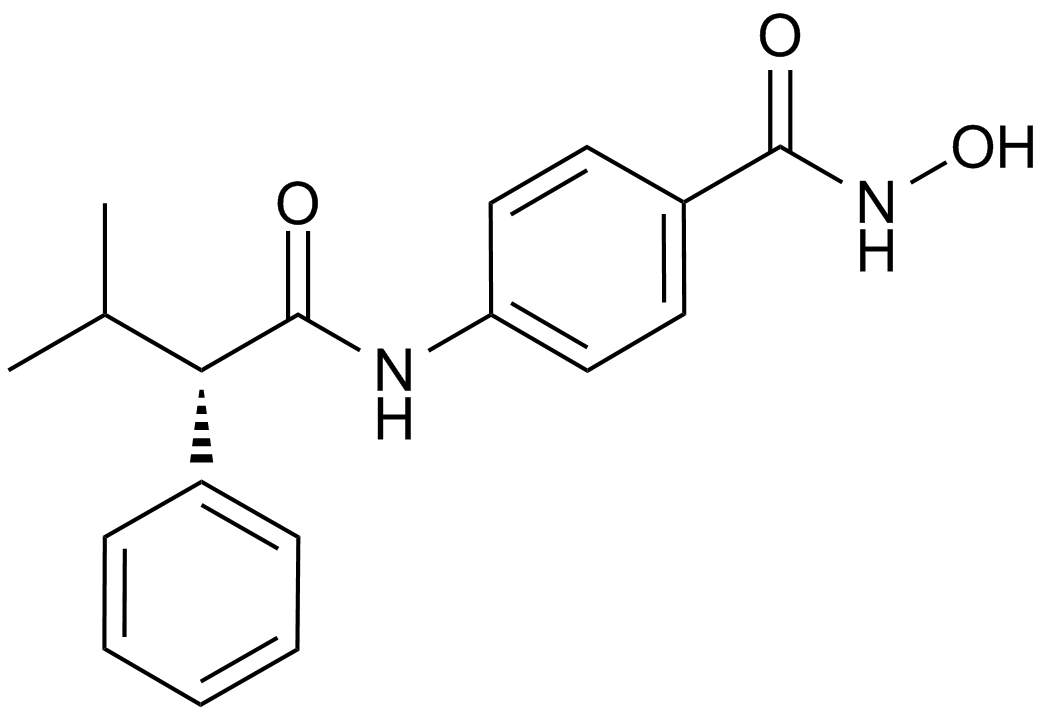
-
GC45385
Ara-G

-
GC46878
Aranciamycin
A fungal metabolite with diverse biological activities

-
GC40116
Aranorosin
Aranorosin, ein wirksames antimykotisches Antibiotikum, wurde aus dem Kulturfiltrat und dem Myzel eines Stammes von Pseudoarachniotus roseus Kuehn isoliert.

-
GC65163
Ardisiacrispin B
Ardisiacrispin B zeigt zytotoxische Wirkungen in multifaktoriell medikamentenresistenten Krebszellen Über ferroptotischen und apoptotischen Zelltod.
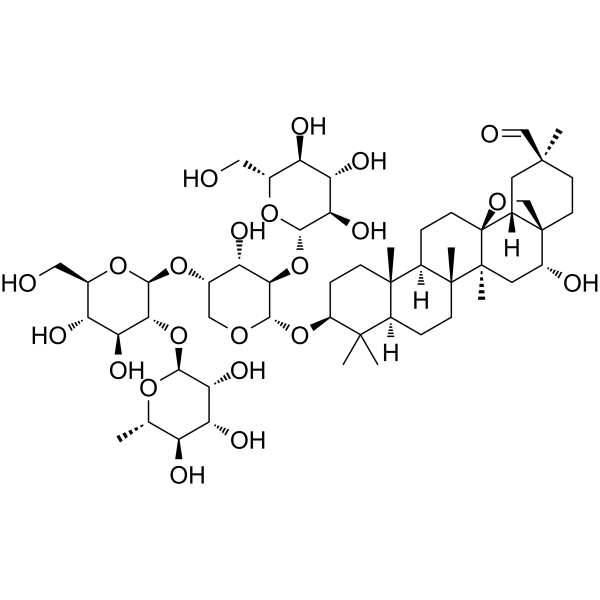
-
GC49314
Arecaidine propargyl ester (hydrobromide)
A muscarinic M2 agonist

-
GC35388
Aristolactam I
Aristololactam I (AL-I), ist der Hauptmetabolit von AristolochinsÄure I (AA-I), ist an den Prozessen beteiligt, die zu NierenschÄden fÜhren.
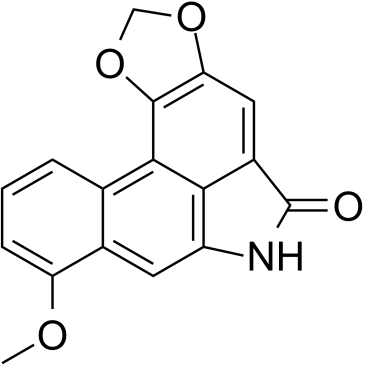
-
GC35395
Arnicolide D
Arnicolid D ist ein aus Centipeda minima isoliertes Sesquiterpenlacton. Arnicolid D moduliert den Zellzyklus, aktiviert den Caspase-Signalweg und hemmt die PI3K/AKT/mTOR- und STAT3-Signalwege. Arnicolid D hemmt die LebensfÄhigkeit von Nasopharynxkarzinom (NPC)-Zellen konzentrations- und zeitabhÄngig.
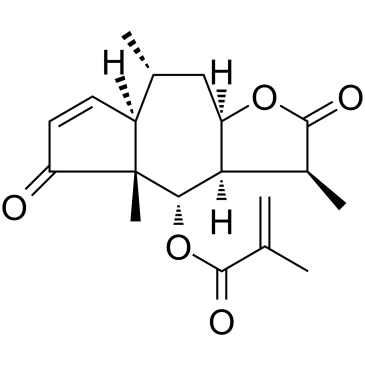
-
GC19037
ARS-853
ARS-853 ist ein zellaktiver, selektiver, kovalenter KRAS G12C-Inhibitor mit einem IC50 von 2,5 μM. ARS-853 hemmt die mutierte KRAS-gesteuerte SignalÜbertragung, indem es an das GDP-gebundene Onkoprotein bindet und die Aktivierung verhindert.
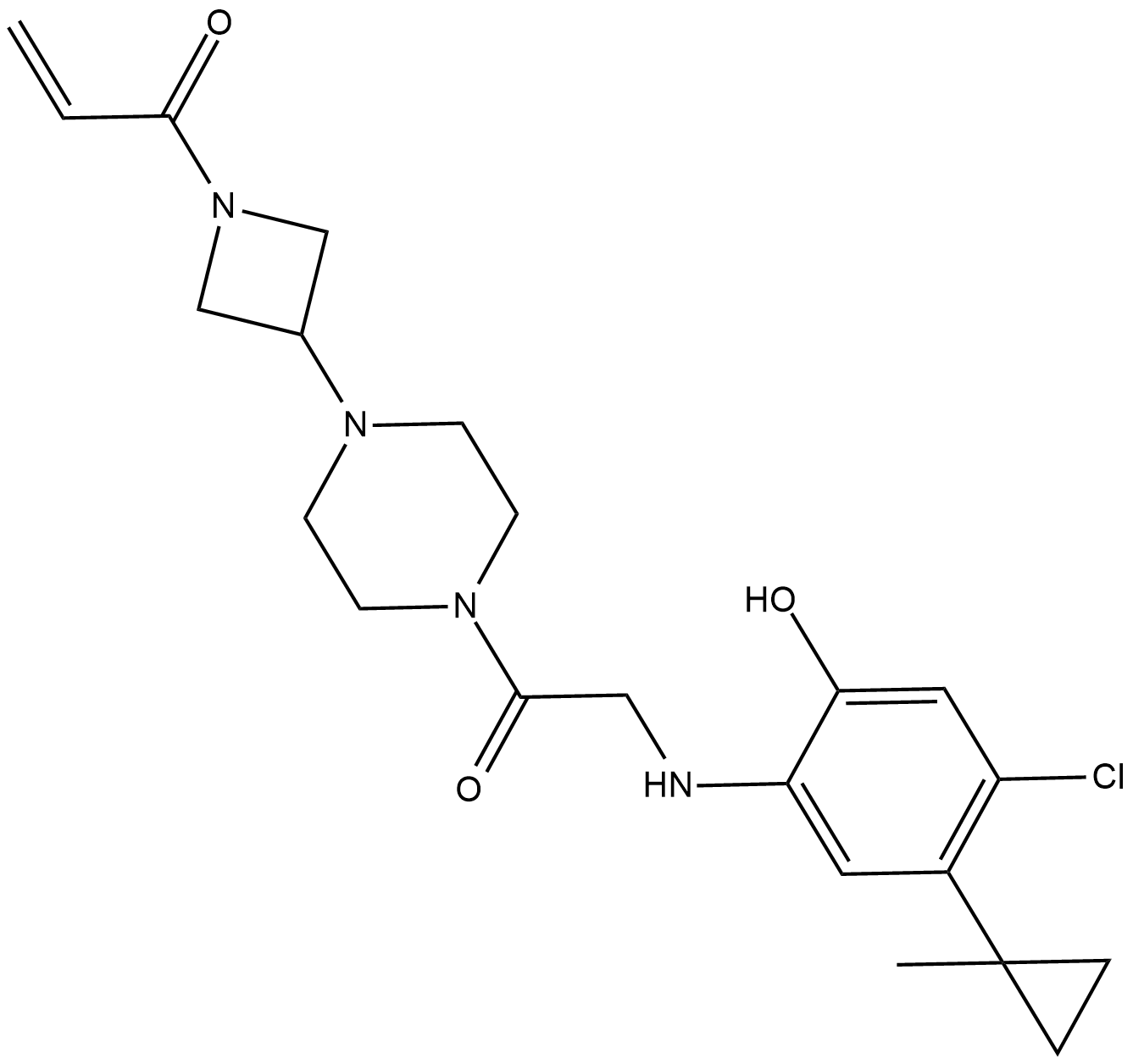
-
GC46882
Artemisinin-d3
An internal standard for the quantification of artemisinin

-
GC10040
Arylquin 1
Arylquin 1, ein Prostata-Apoptose-Response-4 (Par-4)-Sekretagog, zielt auf Vimentin ab, um die Par-4-Sekretion zu induzieren. Arylquin 1 induziert den nicht-apoptotischen Zelltod in Krebszellen durch die Induktion der lysosomalen Membranpermeabilisierung (LMP).
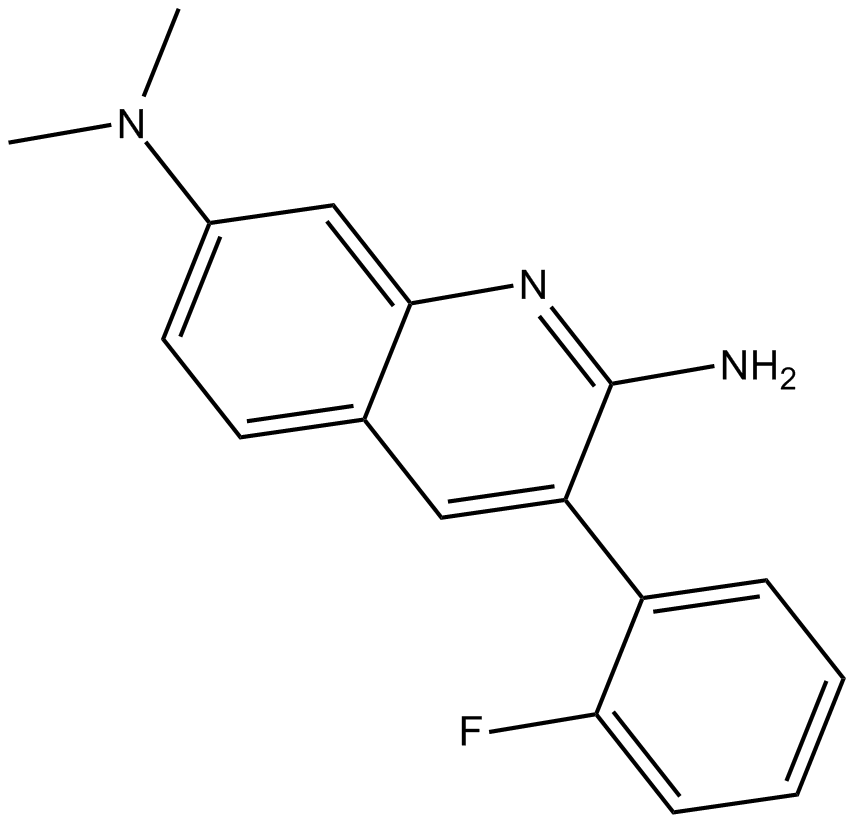
-
GC62615
AS-99
AS-99 ist ein erstklassiger, wirksamer und selektiver ASH1L-Histon-Methyltransferase-Inhibitor (IC50=0,79⋼M, Kd=0,89&7#956;M) mit antileukÄmischer AktivitÄt. AS-99 blockiert die Zellproliferation, induziert Apoptose und Differenzierung, reguliert MLL-Fusionszielgene herunter und reduziert die LeukÄmiebelastung in vivo.
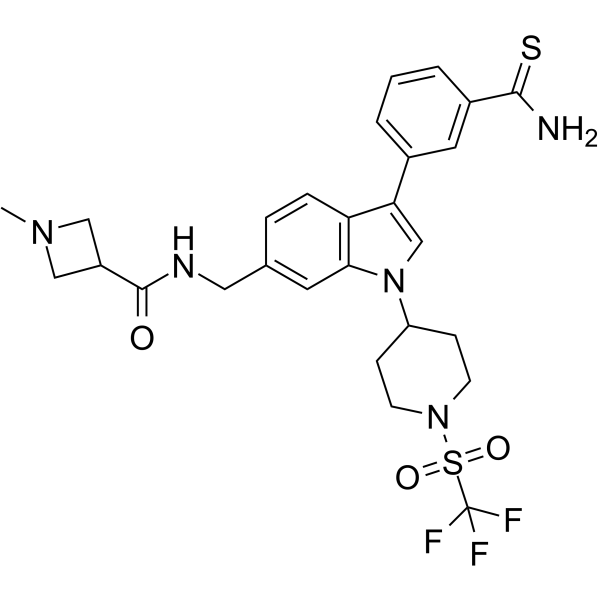
-
GC40715
Ascochlorin
Ascochlorin (Ilicicolin D), ein isoprenoides Antibiotikum, vermittelt seine Antitumorwirkung hauptsÄchlich durch die UnterdrÜckung der STAT3-Signalkaskade.

-
GC13215
Ascomycin(FK 520)
A potent macrolide immunosuppressant
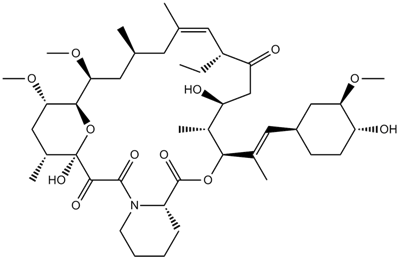
-
GC12070
Ascorbic acid
Ein Elektronendonator
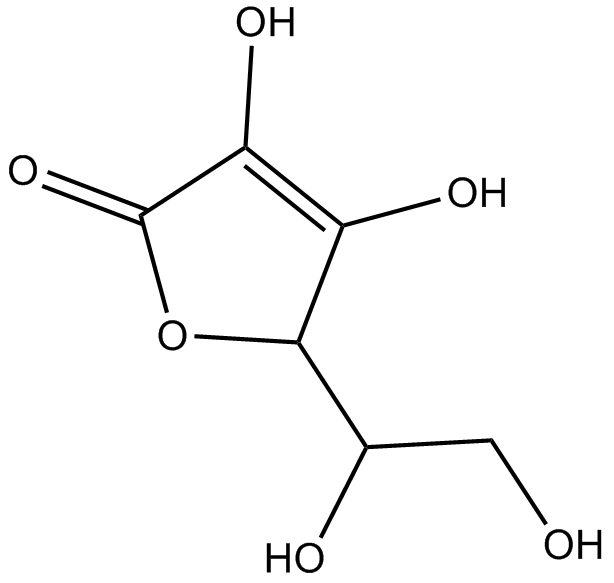
-
GN10702
Asiatic acid
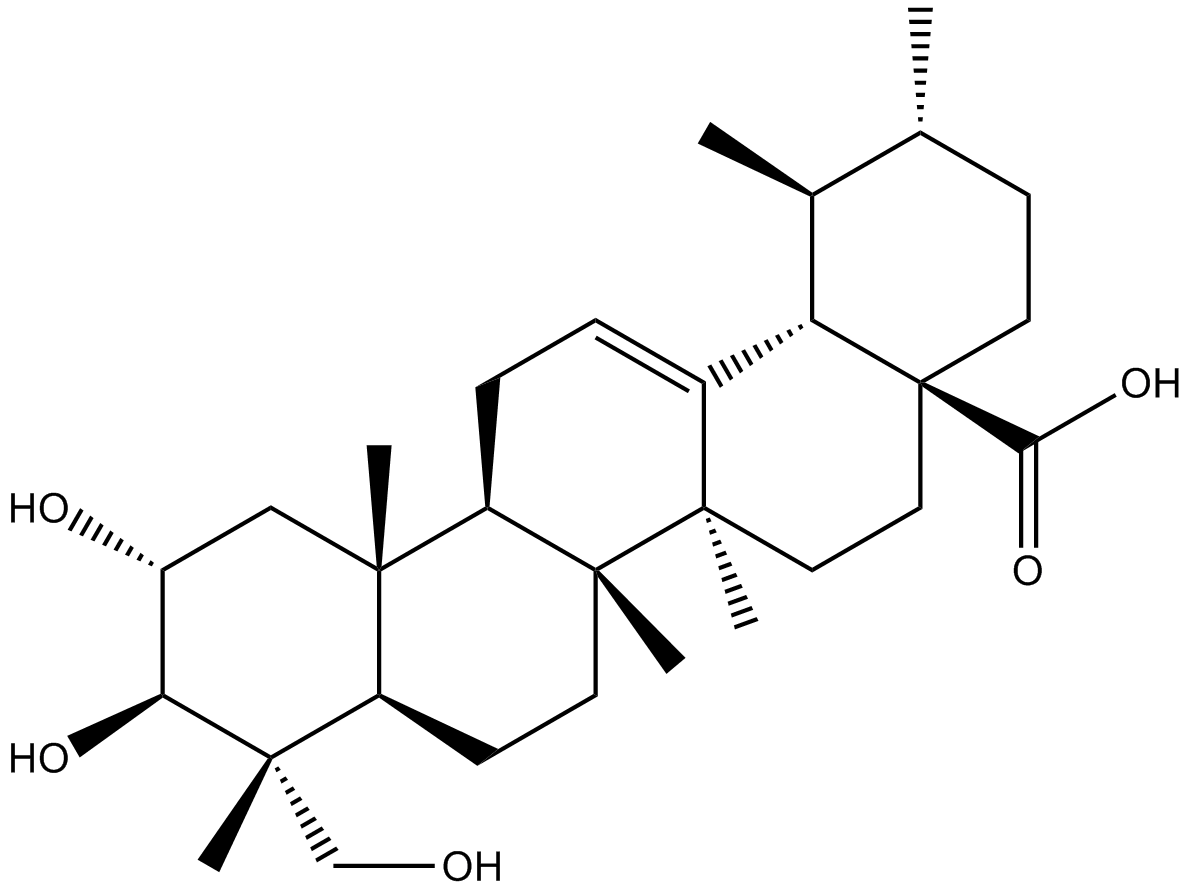
-
GN10534
Asiaticoside
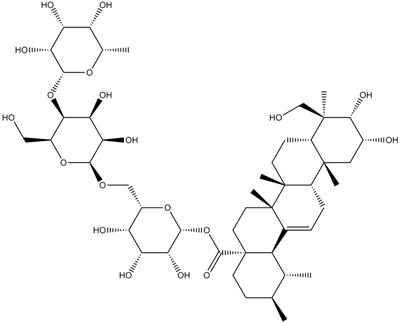
-
GC19041
ASK1-IN-1
ASK1-IN-1 ist ein potenter, oral verfÜgbarer und selektiver ATP-kompetitiver Inhibitor der Apoptose-Signal-regulierenden Kinase 1 (ASK1) mit einem IC50 von 2,87 nM.
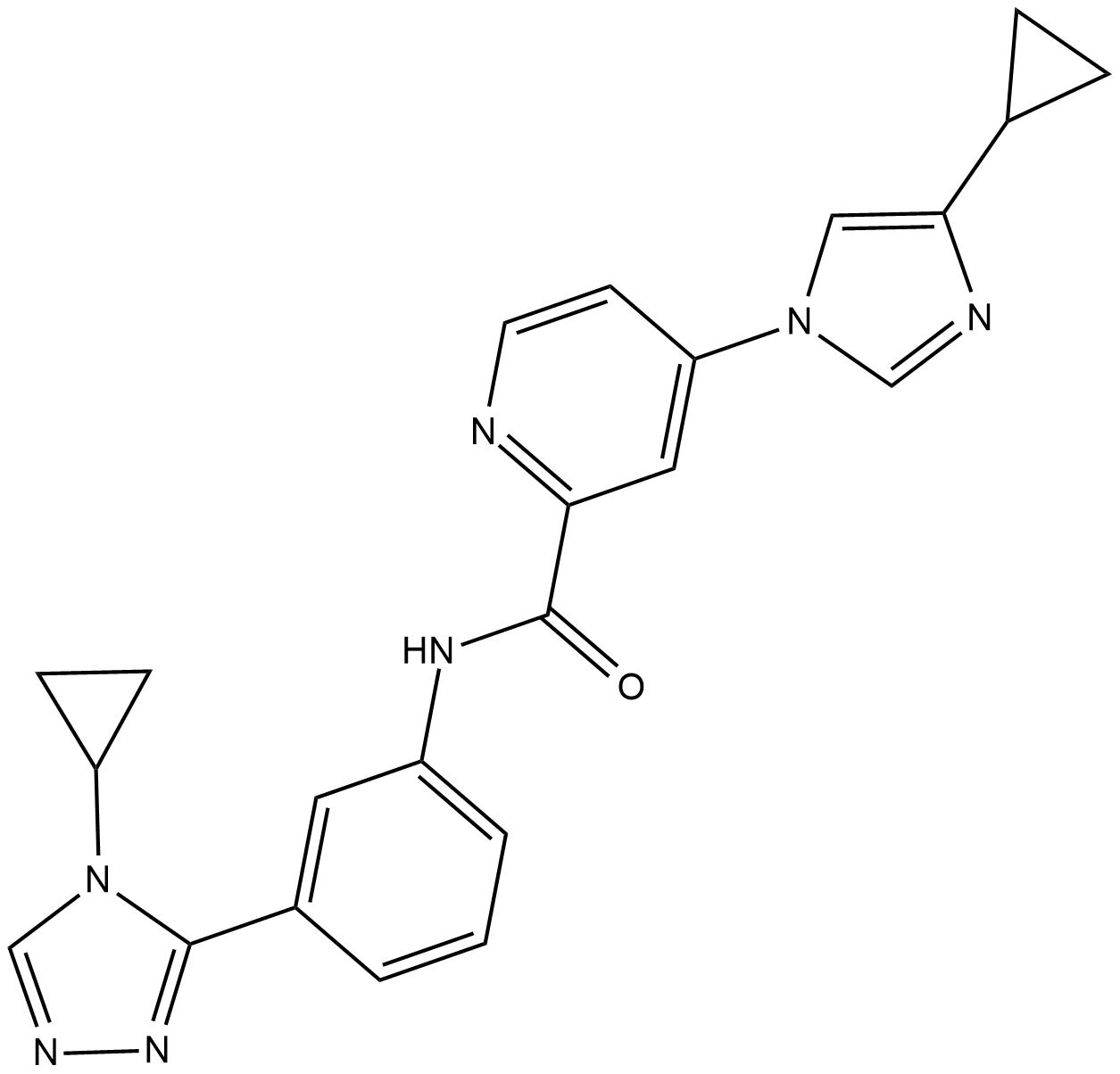
-
GC62426
ASK1-IN-2
ASK1-IN-2 ist ein potenter und oral aktiver Inhibitor der Apoptose-Signal-regulierenden Kinase 1 (ASK1) mit einem IC50 von 32,8 nM.
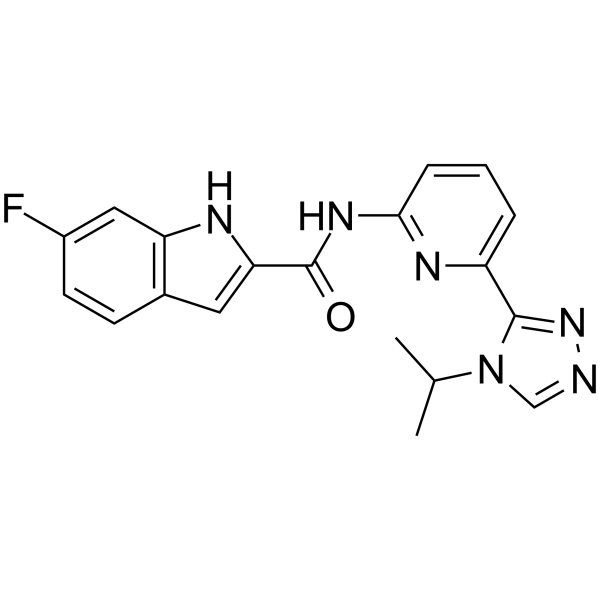
-
GC42858
Aspergillin PZ
Aspergillin PZ ist ein neuartiges Isoindol-Alkaloid aus Aspergillus awamori.

-
GN10064
Asperosaponin VI
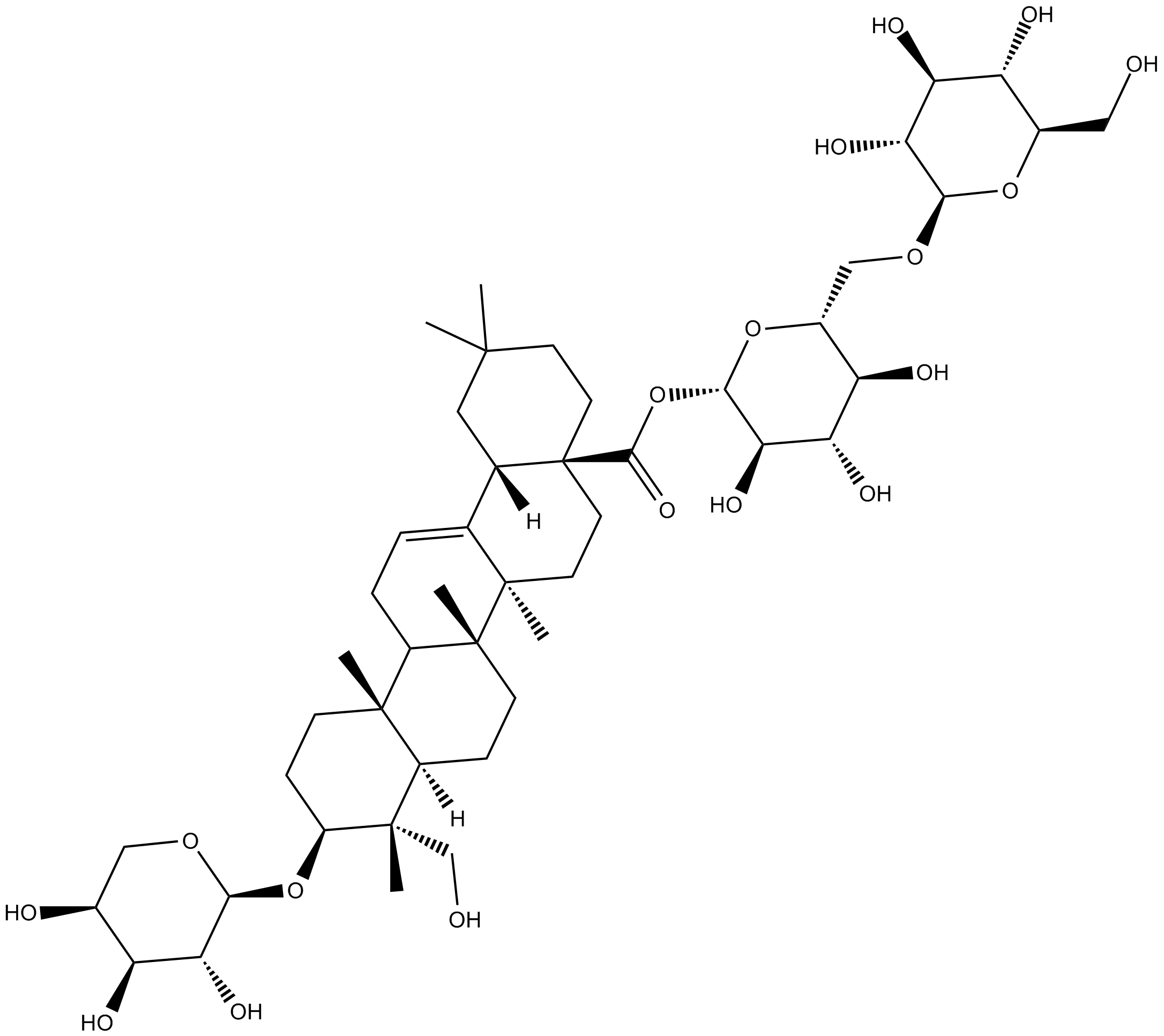
-
GC60603
Asperosaponin VI
A triterpenoid saponin with diverse biological activities
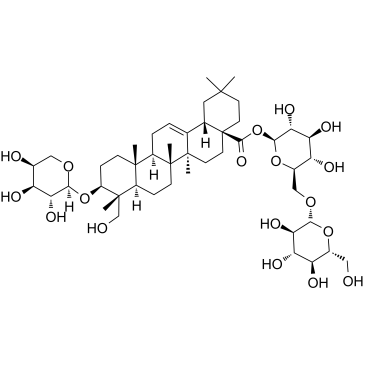
-
GC42860
Aspochalasin D
Aspochalasin D is a co-metabolite originally isolated from A.

-
GC41640
Asterriquinol D dimethyl ether
Asterriquinol-D-Dimethylether ist ein Pilzmetabolit, der Maus-Myelom-NS-1-Zelllinien mit einer IC50 von 28 μg/ml hemmen kann.

-
GN10415
Astilbin
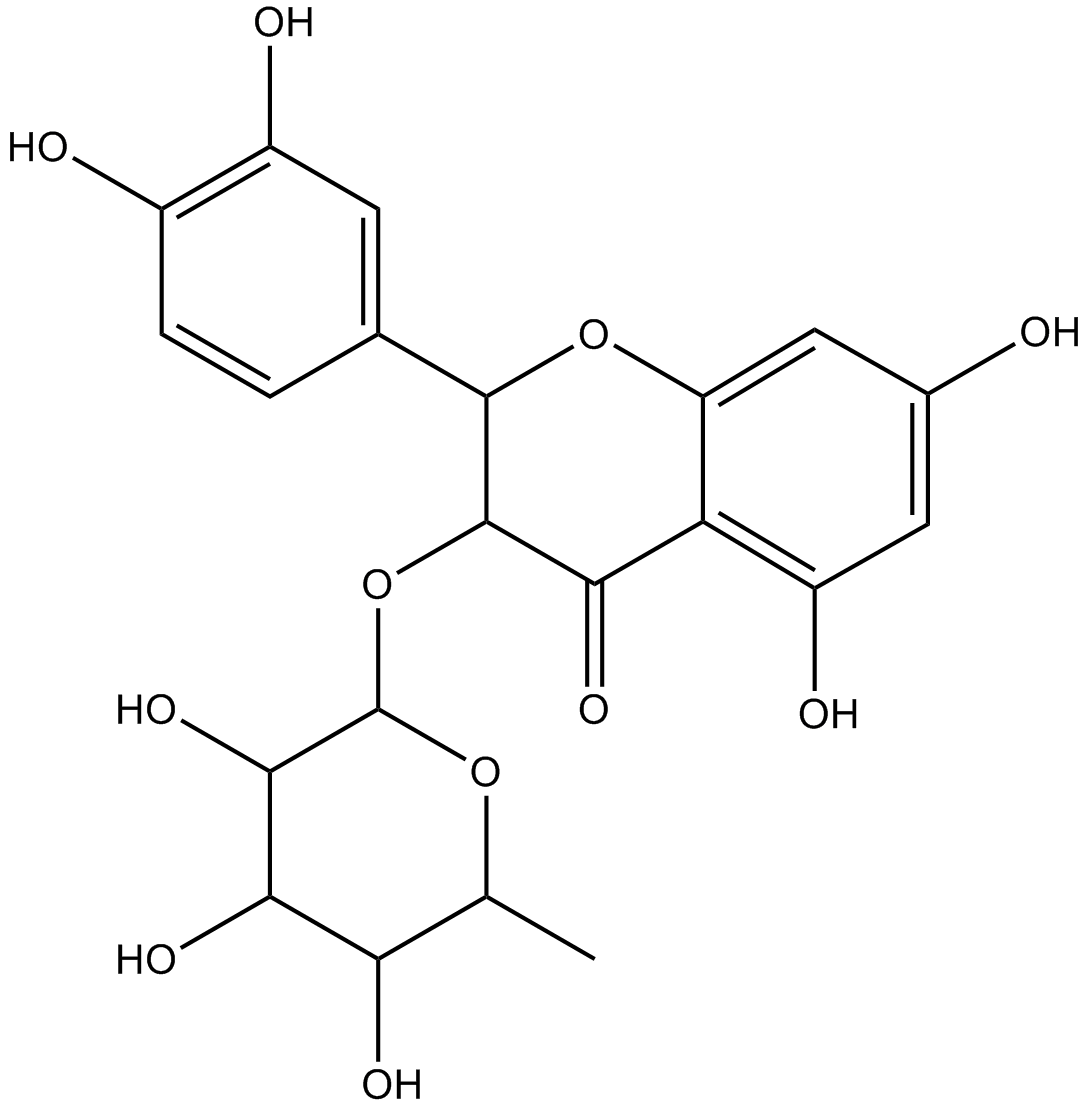
-
GN10561
astragalin
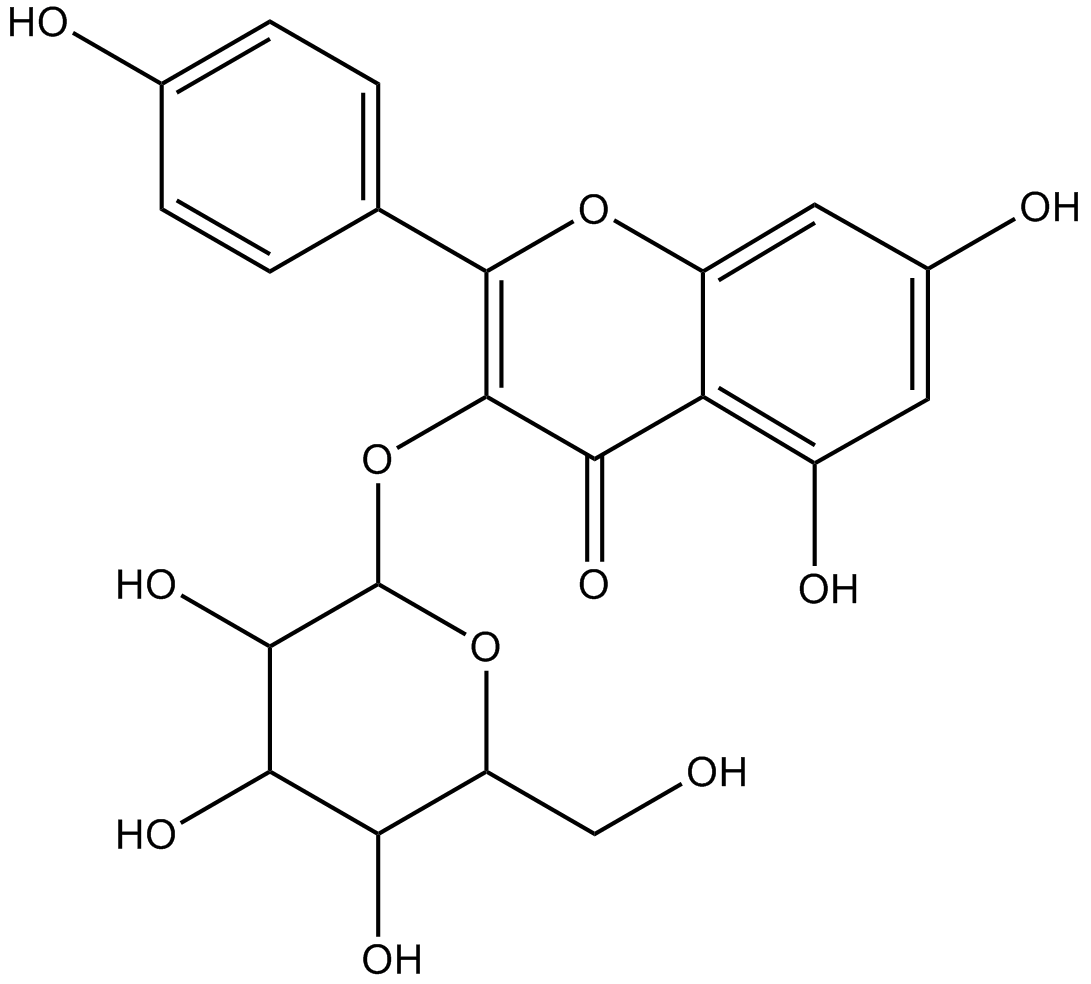
-
GC18109
Astragaloside A
anti-hypertension, positive inotropic action, anti-inflammation, and anti-myocardial injury
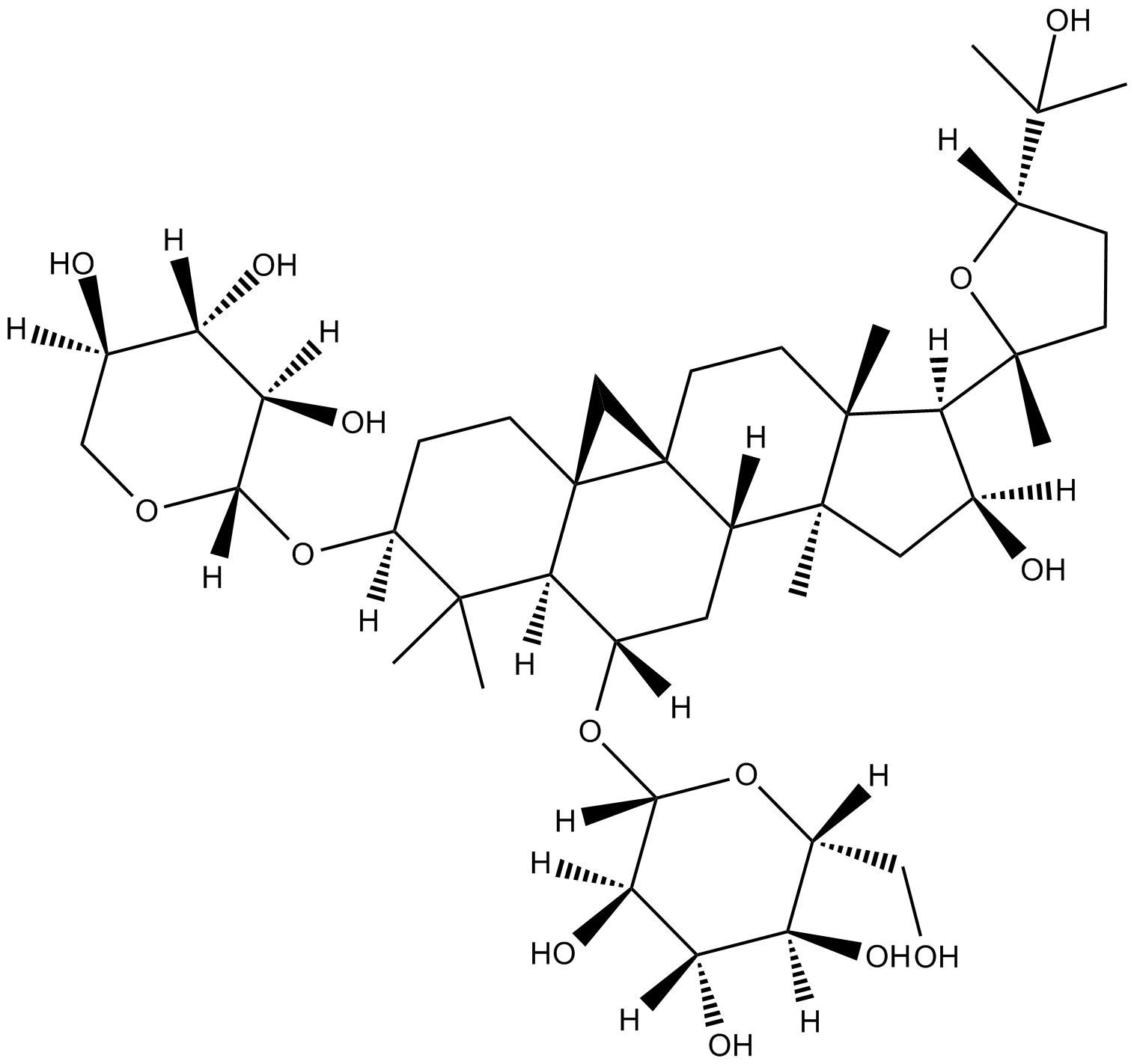
-
GC35415
Astramembrangenin
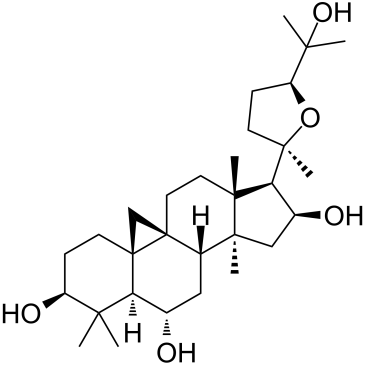
-
GC32803
ASTX660
ASTX660 ist ein oral bioverfÜgbarer dualer Antagonist des zellulÄren Inhibitors des Apoptoseproteins (cIAP) und des X-chromosomalen Inhibitors des Apoptoseproteins (XIAP).
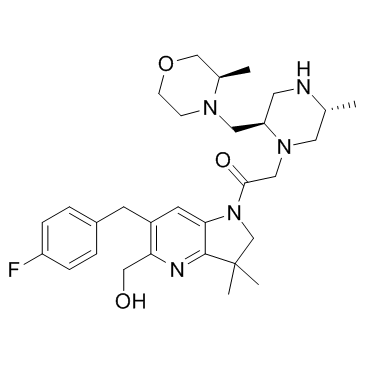
-
GC42863
Asukamycin
Asukamycin is polyketide isolated from the S.

-
GC11106
AT-101
